
Can a Bite From a Brazilian Wandering Spider Cause a Four-Hour Erection?
In many cases, the erection is merely an early warning before the complete shutdown of multiple organ systems., alex kasprak, published aug. 16, 2023.

About this rating
On Aug. 14, 2023, the account First Doctor posted what it asserted to be an "exclusive" finding on the social media platform X, formerly known as Twitter:
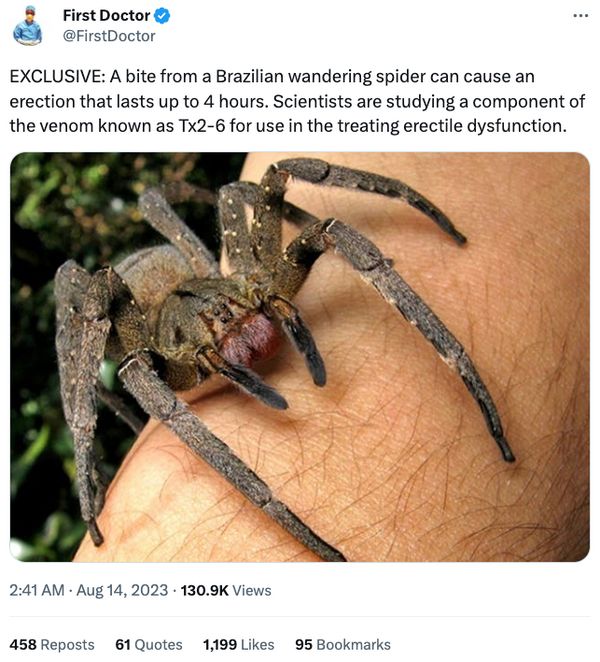
While far from an exclusive — or even a remotely new — finding, the two claims in the tweet were factual. A bite from Phoneutria nigriventer , commonly known as the Brazilian wandering spider, can indeed result in a long-lasting and painful erection, a condition known as priapism when it lasts more than four hours .
While the toxicity and high risk of death posed by the chemical thought to be responsible for the erections makes its use as a potential erectile dysfunction (ED) therapy challenging, if not literally impossible , it has been used to develop similar chemicals that may have therapeutic potential.
Phoneutria nigriventer 's erection-causing effects have been known to science since the 1970s. The 1971 book "Venemous Animals and Their Venom" described priapistic effects of this spider's bite on mice and dogs. The authors also included anecdotal reports from humans who had been bitten:
A pattern which resembles that of dog envenomation is also noticed in humans bitten by Phoneutria nigriventer: local unbearable pain, salivation, visual disturbances, sweating, prostration, priapism, and death.
Research published in 2008 identified the chemical within the venom likely responsible for the erections — a peptide now named PnTx2-6. "[Pn]Tx2-6 enhanced erectile function in [...] rats, via the [Nitrous Oxide] NO pathway," the study reported. "Our studies suggest that [Pn]Tx2-6 could be important for development of new pharmacological agents for treatment of erectile dysfunction."
The interest in this toxin as a treatment for ED stems, in part, because it operates in a completely different way than common ED treatments like Viagra, as reported in 2011 by NBC News:
Viagra, Levitra and other ED drugs on the market work by inhibiting an enzyme called PDE5. To get an erection, a man's body must release nitric oxide, which relaxes the smooth muscle around the arteries of the penis, allowing for his blood vessels to dilate. The nitric oxide is a first step in a series of chemical reactions that allow this muscle relaxation to take place. One step in the series is cGMP, a signaling molecule that acts to keep the muscles relaxed. PDE5 degrades cGMP. That's a good thing for ensuring that erections don't last forever, but too much PDE5 can mean an erection doesn't happen at all. By blocking the enzyme, PDE5 inhibitors solve the problem. The spider toxin works differently. Instead of affecting PDE5, the compound seems to trigger nitric oxide release, acting directly to relax the smooth muscles. Because about 30 percent of patients don't respond to PDE5 inhibitors, the toxin could provide an alternative to ED treatments currently on the market, [Study author Kenia] Nunes said."
In 2022, the same research group responsible for identifying PnTx2-6 published a paper arguing, in part, that due to the extreme pain and high toxicity of the chemical, its "therapeutic use is impossible," but that it is "an excellent pharmacological tool for studying erectile function." That study synthesized a new peptide, PnPP-19, based on the toxic original.
Based on studies performed on laboratory mice, PnPP-19 appears to have the potential to cause erections without the pain or toxicity of the spider venom:
This synthetic peptide also potentiates erectile function via NO/cGMP, but it [...] displays nontoxic properties in animals even at high doses. PnPP-19 effectively potentiates erectile function not only after subcutaneous or intravenous administration but also following topical application.
The assertions in First Doctor's post were factual because the priapism caused by Phoneutria nigriventer's bites have been well-documented and well-studied for decades and because the active ingredients in that venom have been used to investigate new ED therapies. As such, we rate the claim as "True."
Bücherl, Wolfgang, and Eleanor E. Buckley. Venomous Animals and Their Venoms: Venomous Invertebrates. Elsevier, 2013.
Nunes, K. P., et al. "Tx2-6 Toxin of the Phoneutria Nigriventer Spider Potentiates Rat Erectile Function." Toxicon : Official Journal of the International Society on Toxinology, vol. 51, no. 7, June 2008, pp. 1197–206. PubMed Central, https://doi.org/10.1016/j.toxicon.2008.02.010.
Silberman, Michael, et al. "Priapism." StatPearls, StatPearls Publishing, 2023. PubMed, http://www.ncbi.nlm.nih.gov/books/NBK459178/.
Silva, Carolina Nunes da, et al. "From the PnTx2-6 Toxin to the PnPP-19 Engineered Peptide: Therapeutic Potential in Erectile Dysfunction, Nociception, and Glaucoma." Frontiers in Molecular Biosciences, vol. 9, 2022. Frontiers, https://www.frontiersin.org/articles/10.3389/fmolb.2022.831823.
"Spider Venom Shows Promise for Treating Erectile Dysfunction." NBC News, 7 Sept. 2012, http://www.nbcnews.com/health/health-news/spider-venom-shows-promise-treating-erectile-dysfunction-flna1B5794477.
By Alex Kasprak
Alex Kasprak is an investigative journalist and science writer reporting on scientific misinformation, online fraud, and financial crime.
Article Tags

Brazilian Wandering Spider Bite: Is It Poisonous? What You Need to Know
The Brazilian wandering spider, known scientifically as Phoneutria, is a genus of spiders native to South and Central America.
They have garnered attention for their venomous bite, which can cause various symptoms and has the potential to be fatal.
This article will delve into the nature of the Brazilian wandering spider’s bite and its potential effects on humans.
Brazilian wandering spiders are notorious for having one of the most venomous bites among spiders in the world.

The severity of a bite’s effects is dependent on the amount of venom injected, and in some instances, the bite might not be as harmful as anticipated.
However, it is essential to be aware of the possible symptoms and seek immediate medical attention if bitten.
Some symptoms of a Brazilian wandering spider bite may include pain at the bite site, difficulty breathing, blurred vision, and sweating.
In severe cases, the bite can also cause high blood pressure, vomiting, and even death.
Prompt treatment can help mitigate the potential harm caused by these venomous bites and prevent long-lasting health consequences.
Brazilian Wandering Spider: Overview
The Brazilian wandering spider , also known as banana spiders , can be found primarily in South America. They prefer:
- Tropical forests
- Subtropical areas
- Human settlements
Physical Characteristics
Brazilian wandering spiders have the following features:
- Size: Up to 2 inches (5 cm) in body length
- Leg span: Can reach up to 6 inches (15 cm)
- Hairy: Present on their legs and abdomen
- Color: Varies from brown to black, with some species showcasing red or orange patterns
Phoneutria nigriventer is one species within this group.

Source: Pavel Kirillov from St.Petersburg, Russia , CC BY-SA 2.0 , via Wikimedia Commons
These spiders demonstrate unique behavior:
- Nocturnal : They’re more active at night.
- Aggressive : They have a defensive posture when threatened, which includes lifting their front legs.
- Venomous : They possess a potent venom that can be dangerous to humans.
Table: Brazilian Wandering Spider vs. Common House Spider
The Venomous Bite
Venom composition.
The Brazilian wandering spider, also known as Phoneutria, contains a complex cocktail of toxins in their venom. Some of the critical components include:
- Neurotoxins
- Insecticidal peptides
- Pain-inducing substances
Envenomation and Its Effects
When a Brazilian wandering spider bites, it injects venom that can lead to various symptoms such as:
- Pain that radiates from the bite
- Muscle cramps
- Increased sweating
Although bites are rarely fatal, serious complications can arise when left untreated, potentially leading to death.
Comparison with Other Venomous Spiders
The Brazilian wandering spider is considered one of the deadliest spiders due to its potent venom.
However, antivenom is available for its bite, significantly reducing the risk of severe complications.
In comparison, other venomous spiders like the black widow , brown recluse , and Sydney funnel-web spider are also known for their potent venom but have varying severity of symptoms.

Source: Bernard DUPONT from FRANCE , CC BY-SA 2.0 , via Wikimedia Commons
Symptoms and Treatment of Brazilian Wandering Spider Bites
Recognizing the bite.
Recognizing the bite of the Brazilian wandering spider is crucial for seeking proper medical attention.
The main signs of a Brazilian wandering spider bite are:
- Redness and swelling around the bite area
- Intense pain at the bite site
Immediate and Long-term Symptoms
After being bitten by a Brazilian wandering spider, you may experience immediate and long-term symptoms.
Some common immediate symptoms include:
- Excessive sweating
- High blood pressure
- Numbness, usually around the bite area
Brazilian wandering spider bite symptoms can escalate and result in more severe complications like envenomation.
Long-term symptoms can range from:
- Muscle pain or cramping
- Abdominal pain
- Respiratory distress
Prevention and Safety Tips
Avoiding bites.
Brazilian wandering spiders can easily be spotted due to their large body length and venomous bite.
To avoid bites from these spiders, follow these tips:
- Keep an eye out : Be cautious in areas where spiders are common.
- Protective clothing : Wear long-sleeved shirts, pants, gloves, and boots when in areas with spider activity.
- Stack materials properly : Minimize empty spaces between stacked materials to reduce hiding spots for spiders.
What to Do if Bitten
If you suspect a bite from a Brazilian wandering spider, take the following first aid steps:
- Clean the bite area with soap and water
- Apply a cold pack to the bite site to reduce swelling
- Antivenom is available for Brazilian wandering spider bites
- Proper treatment can minimize long-term effects and complications
- Delayed treatment may worsen symptoms and lead to severe complications
Unfortunately, antivenom may not be readily available in certain regions. It is important to contact the health authorities immediately, who can help coordinate procurement of the antivenom.
It’s important to note that immediate treatment is crucial as Brazilian wandering spiders are venomous and their bites can lead to life-threatening complications.

Source: Rodrigo Tetsuo Argenton , CC BY-SA 4.0 , via Wikimedia Commons
Frequency of Bites
While the Brazilian wandering spider is notorious for its venomous bite, actual incidents of bites on humans are relatively rare.
These spiders are nocturnal and tend to avoid populated areas during the day.
However, due to their wandering nature, they sometimes find themselves in human habitats, especially in rural or suburban areas close to their natural habitats.
Most bites occur when the spider feels threatened or cornered.
It’s worth noting that not every bite results in envenomation; sometimes, the spider delivers a “dry bite” without injecting venom.
Nevertheless, given the potential severity of a venomous bite, any encounter should be treated with caution.
Interesting Brazilian Wandering Spider Facts
Spider mating and reproduction.
The Brazilian wandering spider or armed spider , scientifically known as Phoneutria fera , is known for its unique mating and reproduction habits.
These arachnids, like other spiders, engage in an elaborate mating dance:
- Males approach females cautiously
- Present a gift (usually prey like crickets)
- Perform vibrations and touches
Once successful in their ambush , males deposit sperm in a female’s reproductive organ through their specialized pedipalps.
Female Brazilian wandering spiders create silk egg sacs to protect their offspring.
These egg sacs can contain up to 1,000 eggs, ensuring the survival of the species.
Unique Uses of Spider Venom
Brazilian wandering spider venom is one of the most potent in the world . The venom has an impact on the nervous system and can cause symptoms similar to a beesting.
However, researchers have found potential uses for this venom, specifically in treating erectile dysfunction.
A peptide in the spider’s venom called Tx2-6 can cause erections.
Studies have shown that this peptide could be a potential alternative to conventional erectile dysfunction treatments.
The Brazilian wandering spider, native to South and Central America, is renowned for its potent venom, making it one of the world’s most venomous spiders.
While their bite can lead to severe symptoms, including pain, blurred vision, and even death, timely medical intervention can mitigate these effects.
Despite their fearsome reputation, these spiders play a vital role in their ecosystem.
Their unique behaviors, from nocturnal habits to intricate mating dances, make them a fascinating subject of study.
As with any venomous creature, understanding and respecting their habitat is key to coexistence.
Reader Emails
Over the years, our website, whatsthatbug.com has received hundreds of letters and some interesting images asking us about Brazilian wandering spiders.
Scroll down to have a look at some of them.
Letter 1 – Wandering Spider from Costa Rica

We believe this is one of the potentially dangerous Wandering Spiders in the family Ctenidae based on this Photographers Direct image.
Letter 2 – Wandering Spider from Costa Rica

Hi Reisa, Back in February 2006, we received two letters with images of spiders from Costa Rica and Ecuador. At that time, we identified them as Wandering Spiders. Eric Eaton wrote: “either in the family Ctenidae or Sparassidae.
They tend to be more common, and even larger than, wolf spiders in the tropics. At least one species, Phoneutria fera, is extremely aggressive, with potentially deadly venom.
Do not mess with large spiders in Central and South America! The venomous types are very difficult to distinguish from harmless species, and in any event, a bite is going to be really painful.
These spiders sometimes stow away in bananas, houseplants, and other exported goods, so they can show up in odd places. Be careful where you put your hands.”
We found a site with an image of Phoneutria fera, and the coloration is different, but the body shape is very similar.
Bugman aka Daniel Marlos has been identifying bugs since 1999. whatsthatbug.com is his passion project and it has helped millions of readers identify the bug that has been bugging them for over two decades. You can reach out to him through our Contact Page .

Piyushi is a nature lover, blogger and traveler at heart. She lives in beautiful Canada with her family. Piyushi is an animal lover and loves to write about all creatures.
1 thought on “Brazilian Wandering Spider Bite: Is It Poisonous? What You Need to Know”
This is Phoneutria boliviensis – the only Phoneutria that occurs in Central America. It seems that this species is considered to be the least dangerous of its genus. All the same, I would not care to be bitten by one.
Leave a Comment Cancel reply
Save my name, email, and website in this browser for the next time I comment.
Notify me of followup comments via e-mail. You can also subscribe without commenting.
Animal Corner
Discover the many amazing animals that live on our planet.
Brazilian Wandering Spider
The Brazilian Wandering Spider (Phoneutria fera) is an aggressive and highly venomous spider . It was first discovered in Brazil hence its name. However, this genus is known to exist elsewhere in South and Central America .
The Brazilian Wandering spider is a member of the Ctenidae family of wandering spiders.
The Brazilian Wandering spider appeared in the Guinness Book of World Records 2007 for being the most venomous animal .
In this particular genus, there are five known similar species whose members are also highly venomous. They include some of the relatively few species of spiders that present a threat to human beings.
Brazilian Wandering Spider Characteristics
The Brazilian wandering spider can grow to have a leg span of up to 4 – 5 inches. They are large hairy spindly-looking spiders who have eight eyes, two of which are large. Brazilian wandering spiders are fast-moving spiders, their legs are strong and spiny and they have distinctive red jaws which they display when angered.
The Brazilian wandering spider is not a Tarantula . Brazilian wandering spiders are not even in the same family group. Tarantulas are harmless to humans and are mostly ambush killers who wait for prey to come to them. Brazilian wandering spiders are active hunters. Brazilian wandering spiders and Tarantulas do have one thing in common, however, they do not eat bananas.
Brazilian Wandering Spider Habitat and Spider Webs
The Brazilian Wandering spider is so-called because it wanders the jungle floor, rather than residing in a lair or maintaining a web. This is another reason it is considered so dangerous. In densely populated areas, the Brazilian Wandering spider will usually search for cover and dark places to hide during daytime, leading it to hide within houses, clothes, cars, boots, boxes and log piles. This usually causes accidents when people disturb them.
The Brazilian Wandering spider is also called the ‘banana spider’ as it is occasionally found within shipments of bananas. As a result, any large spider appearing in a bunch of bananas should be treated with due care.
Brazilian Wandering Spider Diet
Adult Brazilian Wandering spiders eat crickets, other large insects, small lizards and mice. Spiderlings of this species eat flightless fruit flies and pinhead crickets.
Brazilian Wandering Spider Reproduction
All spiders produce silk, a thin, strong protein strand extruded by the spider from spinnerets most commonly found on the end of the abdomen. Many species use it to trap insects in webs, although there are many species that hunt freely such as the Brazilian Wandering spider. Silk can be used to aid in climbing, form smooth walls for burrows, build egg sacs, wrap prey and temporarily hold sperm, among other applications.
Brazilian Wandering spiders reproduce by means of eggs, which are packed into silk bundles called egg sacs. The male spider must (in most cases) make a timely departure after mating to escape before the females normal predatory instincts return.
Mature male spiders have swollen bulbs on the end of their palps for this purpose and this is a useful way to identify whether the spider is male or female. Once the sperm is inside the female spider, she stores it in a chamber and only uses it during the egg-laying process, when the eggs come into contact with the male sperm for the first time and are fertilized. The Brazilian Wandering spiders life cycle is 1 – 2 years.
Brazilian Wandering Spider Venom
Bites from the Brazilian Wandering spider may result in only a couple of painful pinpricks to full-blown envenomed. In either case, people bitten by this spider or any Ctenid should seek immediate emergency treatment as the venom is possibly life threatening.
The Phoneutria fera and Phoneutria nigriventer (two species of wandering spider) are the two most commonly implicated as the most vicious and deadly of the Phoneutria spiders.
The Phoneutria not only has a potent neurotoxin, but is reported to have one of the most excruciatingly painful envenoms of all spiders due to its high concentration of serotonin. They have the most active venom of any living spiders.
One of their members, the Brazilian Huntsman, is thought to be the most venomous spider in the world. Brazilian wandering spiders are certainly dangerous and bite more people than any other spiders.
Check out more animals that begin with the letter B
More Fascinating Animals to Learn About
About joanne spencer.
I've always been passionate about animals which led me to a career in training and behaviour. As an animal professional I'm committed to improving relationships between people and animals to bring them more happiness.
Medical Information

First Aid for Brazilian Wandering Spider Bite
What is a brazilian wandering spider bite.
Brazilian wandering spiders, also known as banana spiders, are one of the most venomous spiders in the world. They are found primarily in South and Central America and are known for their aggressive behavior and wandering tendencies.
Identification:
- Brazilian wandering spiders have a brown body with distinctive yellow markings on their legs
- They have long and slender legs that are covered in spines
- They have a small body, but their legs can span up to 6 inches (15 centimeters)
- They have two large fangs that are often visible when they open their mouth
What are the Causes of Brazilian Wandering Spider Bite?
Brazilian wandering spiders are venomous and are capable of causing serious envenomation when they bite.
- The venom of the spider contains a neurotoxin that attacks the nervous system, causing muscle spasms, breathing difficulties, and other severe symptoms
- The venom can also cause an excessive release of serotonin, leading to increased heart rate, sweating, and elevated blood pressure
What are the Signs and Symptoms of Brazilian Wandering Spider Bite?
The following signs and symptoms of Brazilian Wandering Spider Bite may be noted:
- Severe pain at the site of the bite that may radiate to other parts of the body
- Sweating and tingling sensations in the mouth and tongue
- Muscular twitching, spasms, and cramps
- Difficulty breathing or shortness of breath
- Nausea, vomiting, and abdominal pain
- Increased heart rate and high blood pressure
- Unconsciousness and convulsions
How is First Aid administered for Brazilian Wandering Spider Bite ?
Immediate actions:
- Clean the bite site with soap and water
- Put a wet, cold cloth, or an ice pack on the bite site
- Seek urgent medical attention, and bring the spider with you to help with identification, when possible
First aid administration:
- The First Aid for Brazilian Wandering Spider Bites includes cleaning the bite area and seeking medical attention
Who Should Administer First Aid for Brazilian Wandering Spider Bite?
- First aid for Brazilian Wandering Spider Bites should be administered by someone who is trained in providing first aid, such as a medical professional, a paramedic, or a trained first-aider
- If there is no one available with appropriate training, attempt to apply the pressure immobilization bandage and seek urgent medical attention
What is the Prognosis of Brazilian Wandering Spider Bite?
The prognosis for Brazilian Wandering Spider Bites depends on the severity of the symptoms and the timing of the treatment.
- If prompt medical attention is given, most patients can recover fully without any long-term effects
- However, delayed or inadequate treatment can lead to serious complications and even death
Long-term effects:
- There are generally no long-term effects of Brazilian Wandering Spider Bites if prompt medical attention is given
- However, in rare cases, patients may develop allergic reactions or experience chronic pain, muscle weakness, or other symptoms that persist long after the bite
How can Brazilian Wandering Spider Bite be Prevented?
A few helpful tips to prevent Brazilian Wandering Spider Bites include:
- Wear shoes and gloves when working in the garden or bush
- Check bedding and clothing before use, especially when stored in dark and cool areas
- Keep the house and garden free from clutter, including piles of rocks, leaves, and wood
- Install screens on doors and windows to prevent spiders from entering the house
- Use insecticides and spider repellents
What are certain Crucial Steps to be followed?
- If you live in areas where Brazilian wandering spiders are prevalent, it is essential to take necessary precautions to prevent being bitten.
- Learn how to identify Brazilian wandering spiders and their habitats to avoid them.
- If you suspect that you have been bitten by a Brazilian wandering spider, follow the immediate actions and first aid administration guidelines outlined above.
- Seek urgent medical attention, and bring the spider with you to help with identification.
- Do not attempt to catch or handle the spider, as this can increase the risk of being bitten.
In conclusion, Brazilian wandering spiders are a potentially deadly species of spider found in South and Central America. If you suspect that you have been bitten by a Brazilian wandering spider, it is crucial to seek urgent medical attention as soon as possible. Prevention is key to avoid being bitten, so take necessary precautions to keep yourself and your family safe from these dangerous spiders.
Hashtags: #BananaSpider #FirstAid #SouthAmericanWildlife #SpiderBites #SafetyTips
On the Article

Krish Tangella MD, MBA

Robert Ben Johnston, MD
Please log in to post a comment.
Related Articles
Test your knowledge, asked by users, related centers, related specialties, related physicians, related procedures, related resources, join dovehubs.
and connect with fellow professionals
Related Directories
At DoveMed, our utmost priority is your well-being. We are an online medical resource dedicated to providing you with accurate and up-to-date information on a wide range of medical topics. But we're more than just an information hub - we genuinely care about your health journey. That's why we offer a variety of products tailored for both healthcare consumers and professionals, because we believe in empowering everyone involved in the care process. Our mission is to create a user-friendly healthcare technology portal that helps you make better decisions about your overall health and well-being. We understand that navigating the complexities of healthcare can be overwhelming, so we strive to be a reliable and compassionate companion on your path to wellness. As an impartial and trusted online resource, we connect healthcare seekers, physicians, and hospitals in a marketplace that promotes a higher quality, easy-to-use healthcare experience. You can trust that our content is unbiased and impartial, as it is trusted by physicians, researchers, and university professors around the globe. Importantly, we are not influenced or owned by any pharmaceutical, medical, or media companies. At DoveMed, we are a group of passionate individuals who deeply care about improving health and wellness for people everywhere. Your well-being is at the heart of everything we do.
For Patients
For professionals, for partners.
An official website of the United States government
The .gov means it’s official. Federal government websites often end in .gov or .mil. Before sharing sensitive information, make sure you’re on a federal government site.
The site is secure. The https:// ensures that you are connecting to the official website and that any information you provide is encrypted and transmitted securely.
- Publications
- Account settings
Preview improvements coming to the PMC website in October 2024. Learn More or Try it out now .
- Advanced Search
- Journal List
- Emerg (Tehran)
- v.2(2); Spring 2014

Poisonous Spiders: Bites, Symptoms, and Treatment; an Educational Review
Farzad rahmani.
1 Department of Emergency medicine, Tabriz University of Medical Sciences, Tabriz, Iran
Seyed Mahdi Banan Khojasteh
2 Department of Animal Biology, Faculty of Natural Sciences, University of Tabriz, Tabriz, Iran
Hanieh Ebrahimi Bakhtavar
3 Department of Emergency Medicine, Ardabil University of Medical Sciences, Ardabil, Iran
Farnaz Rahmani
4 Department of Psychiatric Nursing, School of Nursing and Midwifery, Tabriz University of Medical Sciences, Tabriz, Iran
Kavous Shahsavari Nia
5 Road Traffic Injury Research Center, Tabriz University of Medical Sciences, Tabriz, Iran
Gholamreza Faridaalaee
6 Department of Emergency Medicine, Urmia University of Medical Sciences, Urmia, Iran
More than 40,000 species of spiders have been identified in the world. Spider bites is a common problem among people, however few of them are harmful but delay in treatment can cause death. Since the spider bites are risk full to human, they should be taken seriously, especially in endemic areas. Our objective in this review was to study about poisonous spiders and find out treatments of them. Therefore, we collected related articles from PubMed database and Google Scholar. Three important syndromes caused by spider bites are loxoscelism, latrodectism and funnel web spider syndrome. Many treatments are used but much more studies should have done to decrease the mortality. In this review, we describes different venomous spiders according to their appearance, symptoms after their bites and available treatments.
Introduction:
Spiders belong to a branch of invertebrate animals called arthropods. Arthropods have the largest number of species. Along with ticks, mites and scorpions, spiders fall into the subphylum chelicerata and class of arachnids ( 1 , 2 ). The arachnid class has very diverse members in a way that more than 80,000 species belonging to that class have been identified to date. Spiders are a large group of arachnids belonging to the araneae order ( 1 ). More than 40,000 species of spider have been identified to date but the real number is estimated at 4 times more than that number ( 3 ). Except for two small groups in the arachnid family, all spiders have poison glands and release their secretions into their venom sacs near their chelicerae. However, the majority of spiders do not bite humans and except for a few cases, they are not harmful to the human being or other mammals ( 2 ).Spider bites are common but the majority of species create little clinical presentations ( 3 ). There is only one aggressive spider named funnel-web in Australia, which attacks the human being without provocation. The majority of venomous spiders are found in Latin America. These large spiders are quite aggressive and their venom is pharmacologically highly toxic. Their bite results in severe pain, neurotoxic effects, diaphoresis, severe allergic reaction and priapism ( 1 ). Other spiders normally exhibit aggressive behavior after being trapped, injured or provoked. The severity of reactions to spider venom depends on factors such as its amount, site of biting and its duration and age and health condition. Mortality due to spider bite is rare ( 2 ). Spider venom includes different peptides and substances affecting sodium, calcium and potassium channels in neurons and also glutamate and acetylcholine receptors ( 4 ).Spider bite victims develop symptoms such as pain and swelling in the site of biting, necrosis, pyrexia, pulmonary edema, respiratory distress, hypertension, kidney dysfunction and death. Treatment protocol in the case of critically ill patients includes supportive measures and antivenom injection. Respiratory support and monitoring the hemodynamic status of these patients are of fundamental importance ( 5 ). Highly venomous spiders, funnel-web in Australia and armadeiras (armed spiders) in South America require antivenom and intensive therapeutic interventions ( 6 ). Three important syndromes are caused by spider bites: latrodectism, loxoscelism, and funnel-web spider syndrome ( 7 ). Here, we discuss about poisonous spiders and find out treatments of them.
Introduction of venomous spiders
This section describes different venomous spiders according to their appearance, symptoms after their bites and available treatments. Therefore, we collected related articles from PubMed and Google scholar ( Figure 1 ).

Flowchart of study
a) The brown recluse spider
The brown recluse spider is recognized by the violin-shaped marking on its back ( Figure 2 ). This spider takes rest during the day and is not aggressive but it will attack in the case of provocation. Patients are usually bitten by wearing clothes and shoes with spiders in them ( 2 ).

Brown Recluse Spider. Photograph by Richard S.Vetter.Reproduced with permission from:australianmuseum.net.au
Loxoscelism syndrome is the symptoms caused by the bite of the brown recluse spider. This spider's bite is usually painless but it later becomes an inflammatory, hemorrhagic and painful lesion ( 8 ). Necrosis spreads a few days following the bite and loxoscelism syndrome results in dermatitis necrosis in the site of biting, around which becomes red, white and blue, respectively ( 9 ). The venom of this spider contains hyaluronidase and sphingomyelinase D enzymes and results in necrosis. Moreover, neutrophil activity and platelet aggregation and thrombosis exacerbate necrosis ( 8 ). Local manifestations of the bite of this spider include edema, inflammation, hemorrhage, damage to the vessel wall, thrombosis, and necrosis ( 10 ) but systematic symptoms including acute renal failure, rhabdomyolysis and intravascular hemolysis have also been reported ( 11 ). In some cases, severe coagulopathy can result in stroke ( 7 ).Considering extensive differential diagnosis for skin necrosis, the standard criteria for the diagnosis of loxoscelism syndrome is capturing the spider during biting or capturing it in the place where biting occurred and its confirmation by a reliable arachnologist( 12 ).
Dapsone, antihistamines, colchicine, corticosteroids and hyperbaric oxygen have been used for treatment. Treatment with dapsone can alleviate bite marks and symptoms ( 8 , 13 ). Antivenom reduces the size of the necrotic area. The faster the antivenom is administered, the less the manifestations. It has been proven useful during the first 4 hours after the bite but according to an investigation, it was useful even after 12 hours ( 14 ).
The bite-induced necrosis spreads in a few days and completes in a few weeks. Treatments include initial debridement and in later stages, after improvement of the inflammation, graft is used in case of severity ( 9 ).
b) Hobo spider
Hobo spider is a brown-colored spider with gray marks along its body ( Figure 3 ). The reason for its name is its aggressive behavior following slight provocation. Symptoms induced by its bite are similar to those of the brown recluse spider but necrosis is rare and permanent scar is probable on the site of biting ( 12 ). The cause of necrosis is the hemolytic property of the venom or transmission of pathogenic bacteria inside the site of biting ( 15 ). The systemic symptoms of biting are reportedly cephalalgia and in some, rare cases anaphylaxis and death. The treatment is similar to that of the brown recluse spider. Moreover, resection should not be conducted before the completion of the necrosis process ( 8 ).

Eratigena-Agrestis (Hobo) Spider. Reproduced with permission from:www.spiders.us
c) Black widow spider
Black widow spiders have a black hairless body. Males are smaller than females. Its major characteristic is a red marking on its abdomen similar to an hourglass ( Figure 4 ). It is not aggressive under normal circumstances but attacks if disturbed, especially while protecting its egg sacs. Moreover, it is the most important venomous spider in North America and Australia ( 2 , 3 ). Its venom is alpha-latrotoxin (neurotoxic venom) which results in the exocytosis of synaptic vesicles from parasympathetic terminals due to the stimulation of calcium-dependent mechanisms, releasing catecholamines and acetylcholine ( 8 ).

Black Widow Spider (Photograph by Eric R. Eaton. Reproduced with permission from bugeric.blogspot.com
The symptoms induced by the bite of this spider are called latrodectism. The pain from its bite is similar to that of a pinprick. A lesion similar to the target lesion can be observed in the site of biting ( 16 ).Latrodectism starts in a few minutes with the development of pain through the whole body and symptoms such as emesis, respiratory failure, delirium, partial paralysis of limbs, abdominal muscle cramps, hypertension, pyrexia, fasciculation and muscle spasm are developed within a few hours ( 17 ). Symptoms may be mistaken with acute abdomen. Mortality following biting is less than 1 % and the risk of death following biting is high in two age spectrums. Bites usually occur during warm months ( 7 ). The chelicerae of this spider rarely leave a mark. Following the bite, erythema, diaphoresis and piloerection are observed around the site of bite in 25 % of the cases ( 3 ). Diagnosis is based on the patient's history. While it can be difficult in children, hypertension, distress, diaphoresis and irritability can suggest diagnosis in these cases ( 18 ).
The treatment of these patients consists of using muscle relaxants, narcotics, analgesics, intravenous calcium and antivenom. Narcotics and benzodiazepines relieve muscle spasms. Antivenom treatment is recommended for children, pregnant women the elderly and also patients with severe local symptoms, severe pains necessitating repeated administration of narcotics and systematic symptoms ( 3 ). In the case of IV administration, the antivenom should be diluted and injected slowly ( 17 ). However, some centers have recommended IM administration in order to reduce its complications. In the case of IM administration, the effect is delayed and symptoms take longer to improve ( 3 ) (within 1-5 days). Some may suffer from chronic pains even after proper antivenom treatment ( 18 ).
d) Armadeiras (armed spiders)
Armed spiders have long arms. Since they often hide in banana boxes, they are known as banana bunch spiders by locals ( Figure 5 ).The symptom of its bite is severe pain which is observed in 96 % of patients ( 18 ). The bite of this spider can cause respiratory failure and death at both ends of the age spectrum ( 8 ). Its venom is neurotoxic thus stimulates the autonomic nervous system (tachycardia, hypertension, diaphoresis and salivation), priapism, dizziness and visual disturbances ( 19 ). This venom is recommended to be used for controlling permanent pathological pains due to its different compounds and its effect on pain neurons ( 20 ).

Phoneutria, commonly known as Brazilian wandering spider or armed spider. Image source:wikipedia.org
Patients receive supportive treatment including pain and symptom control. There is antivenom for the treatment of these patients but it is used in few cases ( 21 ). With regard to the probability of respiratory failure in these patients, it is contradictory to use narcotics for pain control. Therefore, local nerve block anesthesia is recommended ( 8 ).
e) Funnel-web spider
Funnel-web spider, the most dangerous spider in the world, is aggressive in the absence of provocation ( Figure 6 ) ( 3 ). The structure of this spider’s web is funnel-shaped, hence the name ( 8 ).The venom of this spider is neurotoxin and contains a large amount of peptides ( 22 , 23 ). Delta atracotoxin, one of the peptides in the venom, delay the activation of voltage-dependent sodium channels resulting in repeated stimulation and release of massive neurotransmitters in nerve endings ( 24 ). Robustoxin is another toxin in the venom of this spider which is a fatal peptide and can be used for immunization ( 25 ).

Funnel Web Spider (Reproduced with permission from australianmuseum.net.au
Local symptoms include pain, diaphoresis, hives and piloerection. Systemic symptoms include stimulation of the parasympathetic system (nausea, emesis, salivation, sialorrhea and tearing), cardiovascular system (hypertension, mostly tachycardia and in some rare cases bradycardia and hypotension), nervous system (fasciculation and perioral paresthesia), non-cardiac pulmonary edema (more prevalent in children), agitation, and cephalalgia( 3 ).
Treatment includes supportive measures, elastic bandage for blocking lymph flow, limb immobilization and rapid transportation to the hospital. Antivenom is the definite cure and should be administered up to 15 minutes after opening the bandage. In the case of uncertainty about the bite and exhibition of the first systemic symptoms, 2 vials of antivenom are administered and in the case of severe symptoms 4 vials are administered. Other therapeutic measures include hemodynamic support, ventilatory support and the administration of tetanus vaccine. These measures reduce the risk of neurological complications and mortality and improve the performance of patients after being discharged ( 7 ).
f) Tarantula
Tarantula is recognized by its hairy 3-inch brown or black colored body ( Figure 7 ). This type of spider is kept as pet ( 8 ). Its venom is not dangerous for the human being and merely creates lesions without any specific systemic reaction except for pyrexia. Tarantula’s defense mechanism is the hair on its body which stands out and moves when alarmed ( 2 ). If these hairs enter the eye, they can result in the inflammation of all of the layers of the eye. Eye wash and topical corticosteroids are recommended in the case of uveitis ( 8 ).

Tarantula Spider (Mexican Red Legged Tarantula) Photograph byRicBolzan. Reproduced with permission fromaustralianmuseum.net.au
Recommendations for future
The human being has always been frightened of spiders but few of them are venomous and thus real threat to human health. However, since venomous spiders are sometimes fatal, bites should be taken care of. Moreover, it is recommended to be adequately familiar with necessary treatments. With regard to the identification of venomous spiders in our country including widow spider, which exists in the majority of provinces, healthcare personnel must be familiar with the symptoms of the bites of venomous spiders and it is essential to prepare antivenoms in the country for the treatment of spider bites. Finally, further domestic investigations are necessary on the distribution of venomous spiders and suspected cases of spider bite should be reported to related centers to reduce the damages caused by biting.
Acknowledgments:
We acknowledge Managers of www.spiders.us ; www.australianmuseum.net.au ; www.bugeric.blogspot.com ; and www.wikipedia.org sites for let us to use their own images.
Conflict of interest:
Funding support:, authors’ contributions:.
All authors passed four criteria for authorship contribution based on recommendations of the International Committee of Medical Journal Editors.

Wellcome to SpiderZoon
- Spider Facts
Brazilian Wandering Spider: Size, Bite, Diet and Other Facts
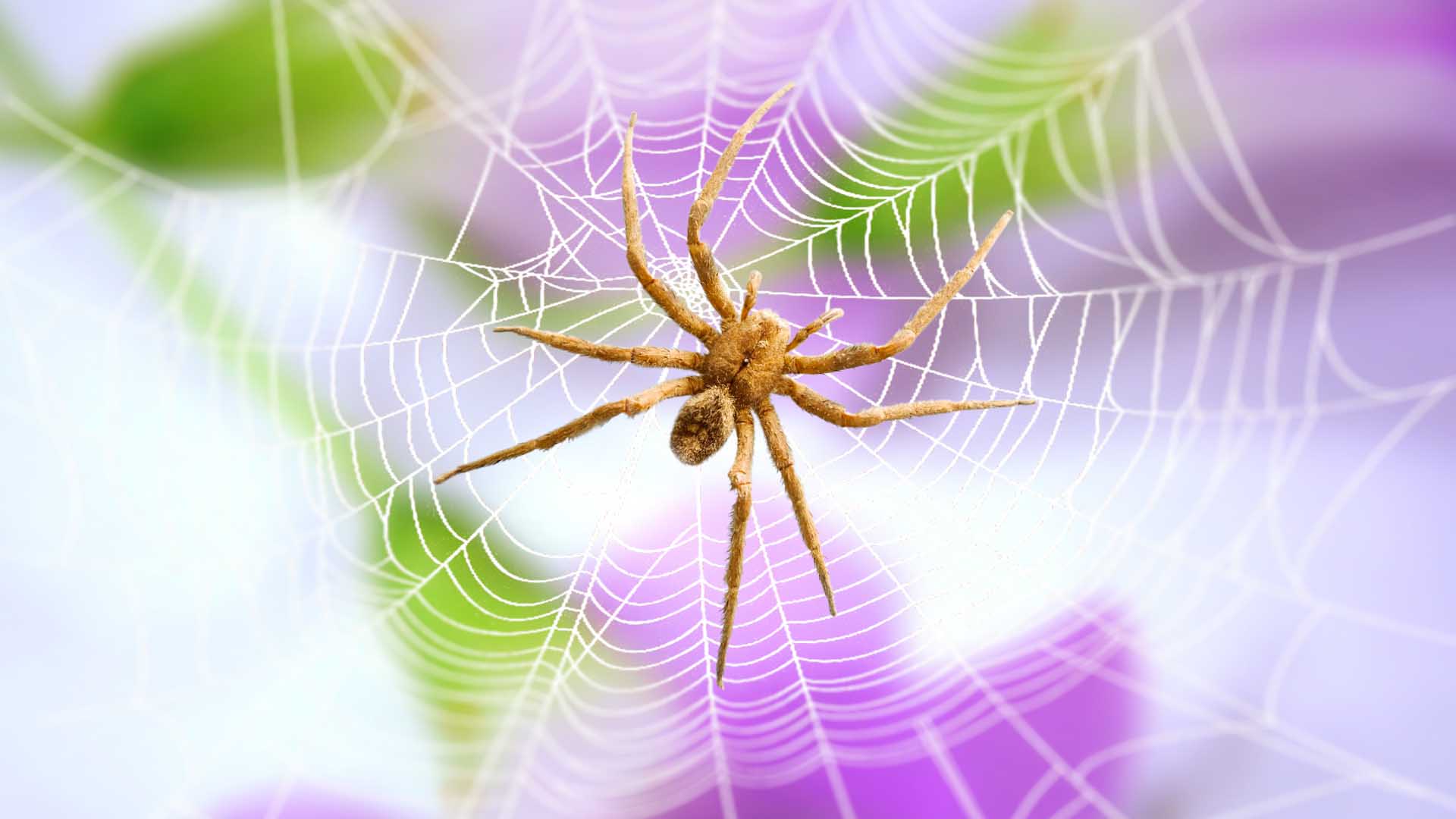
The Brazilian Wandering Spider is a venomous arachnid with a fearsome reputation. This South American rainforest dweller packs a powerful punch, but don’t let its nickname “banana spider” fool you – they’re active hunters, not web-spinners. Despite their size and venom, bites are uncommon as they’re typically shy.
The Brazilian Wandering Spider has garnered significant attention due to its potent venom, which makes it one of the world’s most venomous spiders. Understanding its biology and behavior is crucial for both scientific research and public safety.
Scientific classification
The Brazilian Wandering Spider belongs to the family Ctenidae within the order Araneae. Its scientific classification is as follows:
- Kingdom: Animalia
- Phylum: Arthropoda
- Class: Arachnida
- Order: Araneae
- Family: Ctenidae
- Genus: Phoneutria
The Brazilian Wandering Spider goes by various common names, including “armed spider,” “banana spider,” and “wandering spider.” Synonyms for this species may include Ctenus , which was formerly used for some Phoneutria species.
Distribution and habitat
Distribution:
- South American: Found throughout most of South America east of the Andes mountains, including countries like Brazil (their namesake), Argentina, Paraguay, and up into northern regions.
- Central American Touch: A few species even reach southern Central America.
- Rainforest Dwellers: Primarily found in the lush rainforests of South America.
- Not Picky Places: They can also adapt to other habitats like the Atlantic Forest and even some urban areas.
- Daytime Hideouts: While they wander at night, they seek shelter during the day in places like termite mounds, under rocks, or even (unintentionally) in bananas!
Physical Characteristics
size and weight.
The Brazilian wandering spider is a creepy crawly giant. Their bodies can grow up to 2 inches (5 centimeters) long, but that’s not the scary part. Their legs can span a whopping 7 inches (18 cm), making them look even bigger. They are one of the biggest true spiders by body weight and size.
Despite their impressive leg span, Brazilian wandering spiders are relatively light. They only weigh around 6 grams, which is about the same as two pennies. While they might look imposing, they’re not the heaviest arachnids around.
Coloration and markings
These spiders exhibit a range of colors, including brown, black, and sometimes reddish hues. They often have distinctive markings on their bodies, which can vary between species. These markings may include stripes or patterns that serve as a key identification feature.
Notable features
One of the most notable features of the Brazilian Wandering Spider is its elongated, robust body and long, agile legs. They have sharp fangs, which they use to inject venom into their prey or in self-defense.
Sexual dimorphism
Sexual dimorphism is evident in this species. Females are larger and bulkier than males, while males have longer, more slender legs. Additionally, males possess specialized structures known as pedipalps, which are used during mating.
In the following sections of this article, we will delve deeper into the behavior, venom, and ecological role of the Brazilian Wandering Spider, shedding light on why this species has both fascinated and instilled fear in those who encounter it.
Behavior and Ecology
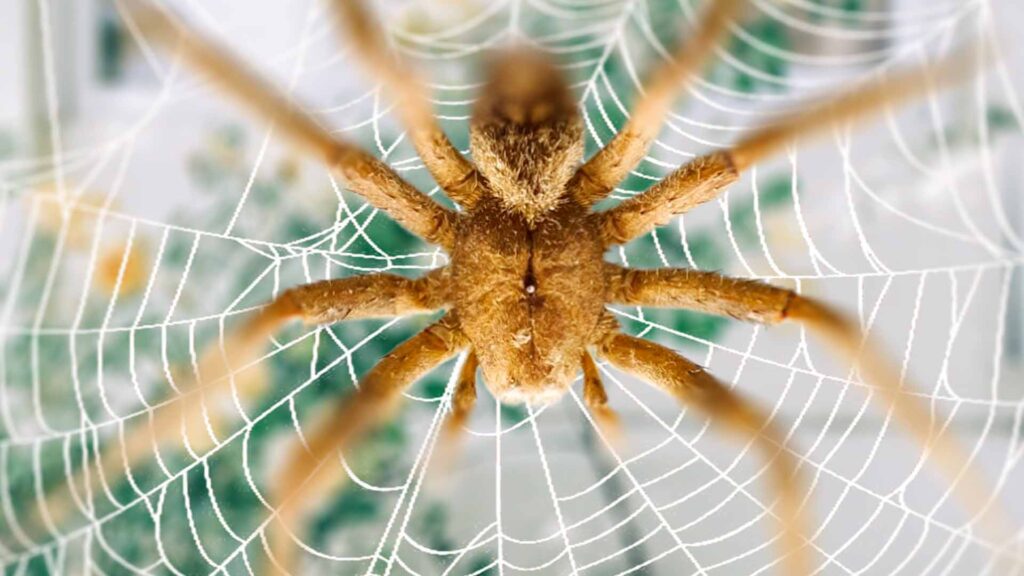
Nocturnal habits
Brazilian Wandering Spiders are primarily nocturnal creatures. They are most active during the night, venturing out of their daytime hiding places to hunt for prey and engage in mating activities. Their nighttime activity allows them to avoid predators and reduce the risk of desiccation in the hot tropical sun.
Hunting and feeding behavior
These spiders are agile hunters and primarily feed on insects, small vertebrates, and other arachnids. They do not build webs to capture prey but instead rely on their excellent senses, including acute vision and touch, to locate and stalk their victims. They often wander in search of food and are known for their swift and lethal strikes. Once they subdue their prey, they inject venom to immobilize it before feeding.
Brazilian Wandering Spiders (Phoneutria) are active hunters and have distinctive feeding behaviors. Here’s an overview of their feeding habits:
- Active Predators: Brazilian Wandering Spiders are not web-builders like many other spider species. Instead, they are active predators. They actively roam their environment in search of prey rather than waiting for insects to stumble into a web.
- Hunting Strategy: When hunting, these spiders use their excellent senses, including acute vision and touch, to locate potential prey. They are known for their agility and speed, which they use to stalk and capture their victims. They have sharp fangs, which they use to deliver a venomous bite to immobilize their prey.
- Diet: Their diet consists primarily of insects and other arthropods, but they are opportunistic feeders and may consume a variety of small creatures, including small vertebrates such as frogs and lizards when the opportunity arises.
- Venom Use: Brazilian Wandering Spiders inject venom into their prey to immobilize and partially digest it. Their venom contains neurotoxins that affect the nervous system of their victims. Once the prey is incapacitated, the spider can feed on it at its leisure.
- Feeding Process: After subduing their prey with a venomous bite, the spider uses its chelicerae (fangs) to break down the prey’s tissues. The venom also helps in predigestion, turning the prey’s insides into a semi-liquid form that the spider can ingest. They can consume both the internal fluids and solid parts of their prey.
- Frequency of Feeding: The frequency of feeding can vary depending on factors such as the availability of prey and the spider’s size. Generally, they need to feed periodically to sustain their energy and growth. Spiderlings may require more frequent meals to support their rapid growth, while adults can go longer periods between meals.
Overall, the Brazilian Wandering Spider’s feeding strategy is well-suited for their active and wandering lifestyle, allowing them to efficiently capture and consume a variety of prey in their natural habitat.
Role in the ecosystem
The Brazilian Wandering Spider plays a vital role in controlling insect populations within its habitat. By preying on a variety of insects and other small creatures, they help maintain ecological balance. Additionally, their presence in the rainforest ecosystem contributes to the overall biodiversity and food web.
Mating and reproduction
Mating in Brazilian Wandering Spiders is a complex and potentially dangerous process. Male spiders must carefully approach and court a receptive female to avoid being mistaken for prey. They use specialized pedipalps to transfer sperm to the female’s reproductive organs. After successful mating, females lay egg sacs containing hundreds of eggs. They guard these sacs and ensure the survival of their offspring until they hatch.
Lifespan and growth
The lifespan of Brazilian Wandering Spiders varies between males and females. Males generally have a shorter lifespan, typically living for a few months to a year after reaching maturity. Females, on the other hand, can live for several years. The growth of these spiders involves a series of molts, during which they shed their exoskeletons to accommodate their increasing size. Molting is a vulnerable period in their lives as their new exoskeleton is initially soft and requires time to harden.
Venom and Envenomation
Composition of venom.
The venom of Brazilian Wandering Spiders is a complex mixture of neurotoxins, cytotoxins, and other enzymes. One of the most significant components is a neurotoxin called PhTx3, which targets the nervous system of their prey.
Toxicity and effects on humans
The venom of these spiders is highly potent and can be lethal to their prey. In humans, envenomation can cause a range of symptoms, including intense pain, muscle cramps, fever, nausea, and in severe cases, paralysis and death. It’s important to note that while their venom is potent, actual fatalities from Brazilian Wandering Spider bites are rare due to the availability of medical treatment.
First aid and medical treatment
In the event of a Brazilian Wandering Spider bite, immediate medical attention is crucial. First aid measures may include cleaning the wound and applying ice to reduce pain and swelling. However, the primary treatment involves antivenom, which can counteract the effects of the spider’s venom.
Cases of envenomation and fatalities
Although fatalities from Brazilian Wandering Spider bites are uncommon, there have been documented cases of severe envenomation, especially in regions where medical treatment is not readily available. These spiders are generally non-aggressive and will bite humans only in self-defense when provoked, or if they feel cornered.
Understanding the behavior, ecology, and venomous nature of the Brazilian Wandering Spider is crucial for both scientific research and public awareness, helping to minimize the risk of envenomation and promote coexistence with this remarkable but potentially dangerous arachnid.
Brazilian wandering spider life cycle
The Brazilian wandering spider has a fascinating life cycle that revolves around hunting and motherhood. Here’s a breakdown:
- Egg Haven: After mating, the female lays hundreds, sometimes even a thousand, eggs in a silken sac. This becomes their protected nursery.
- Tiny Terrors: Hatching from the eggs emerge translucent spiderlings called larvae.
- Nymph Stage: The larvae molt a few times, transforming into nymphs. Think of them as mini-adults but without the ability to reproduce yet.
- Shedding for Size: As nymphs grow, they undergo multiple molts, shedding their outer shell to accommodate their larger bodies.
- Ready to Roam: After the final molt, the spider emerges as a full-fledged adult, complete with reproductive organs. Now, they can join the wandering lifestyle and continue the cycle.
The life cycle begins when a female Brazilian Wandering Spider lays her eggs. She typically creates an egg sac made of silk and deposits it in a concealed location, such as a tree hollow or leaf litter. Inside the sac, she may lay hundreds of eggs. The female guards the egg sac and ensures its protection until the spiderlings hatch. The duration of the egg stage varies depending on environmental conditions but generally lasts for a few weeks.
Spiderling Stage
After the incubation period, spiderlings (young spiders) emerge from the egg sac. They are extremely vulnerable at this stage and rely on their mother’s protection and guidance. Spiderlings are miniature versions of adult spiders but lack the full coloration and size. They disperse from the nest once they have molted and are capable of hunting on their own. During this stage, they grow rapidly by molting, shedding their exoskeletons to accommodate their increasing size.
Juvenile Stage
As spiderlings continue to molt and grow, they progress into the juvenile stage. During this phase, their coloration becomes more distinct, and they start to develop the characteristic features of adult Brazilian Wandering Spiders. They become increasingly independent and begin to exhibit hunting behaviors. The duration of the juvenile stage can vary but often lasts several months.
Sub-Adult Stage
The sub-adult stage is an intermediate phase between juvenile and adult. At this point, the spiders are closer in size and appearance to adults but have not yet reached sexual maturity. They continue to molt, with the frequency of molting gradually decreasing as they approach adulthood. Sub-adult spiders may exhibit more territorial behaviors as they compete for resources and prepare for eventual mating.
Adult Stage
Upon reaching sexual maturity, Brazilian Wandering Spiders enter the adult stage. This is when they are fully developed and capable of reproduction. Females are larger and bulkier than males, and males possess specialized structures called pedipalps, which they use during mating. Adult spiders engage in mating activities, and females lay eggs to continue the life cycle. Adult Brazilian Wandering Spiders can live for several years, with females typically having longer lifespans than males.
Understanding the life cycle of these spiders is essential for studying their behavior, reproductive biology, and population dynamics. It also provides insights into their adaptation strategies in the complex ecosystems of South and Central America.
Brazilian Wandering Spider Bite
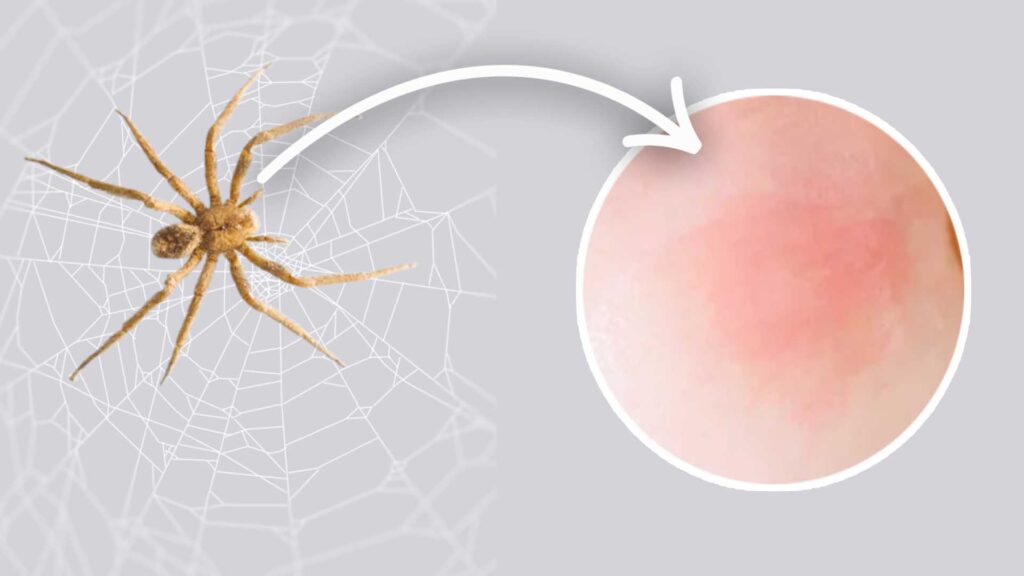
Brazilian Wandering Spiders are known for their potent venom and, occasionally, their bites on humans. While bites are relatively rare due to the spider’s non-aggressive nature, understanding the consequences of a bite is crucial for public safety.
Studying Brazilian Wandering Spider bites is of great interest for several reasons. It helps healthcare professionals provide appropriate medical treatment, raises awareness among communities in spider habitats, and contributes to our understanding of venomous arachnid envenomations.
The venom of Brazilian Wandering Spiders is a complex mixture of neurotoxins, cytotoxins, and enzymes. It contains various components, including PhTx3, which is a potent neurotoxin affecting the nervous system.
Brazilian Wandering Spider bites can have a range of effects on the human body, including intense pain, muscle cramps, fever, nausea, and in severe cases, paralysis. The severity of the symptoms depends on factors such as the amount of venom injected and the individual’s sensitivity to the venom. There are several types of spider bites .
Symptoms of a Brazilian Wandering Spider Bite
Local symptoms
- Intense pain
- Itching or burning sensation
- Formation of blisters or lesions
Systemic symptoms
- Muscle cramps and spasms
- Abdominal pain
- Nausea and vomiting
- Elevated heart rate
- Hypertension (high blood pressure)
- Respiratory distress
Severity and variations
The severity of Brazilian Wandering Spider bite symptoms can vary widely. In some cases, symptoms may be mild and resolve on their own, while in severe envenomations, life-threatening complications can occur. Individual reactions to the venom can also vary, making it challenging to predict the exact outcome of a bite.
First Aid and Immediate Response
Steps to take after a bite
Immediate response to a Brazilian Wandering Spider bite should include:
- – Washing the bite area with soap and water.
- – Applying a clean, cool compress to reduce pain and swelling.
- – Immobilizing the affected limb or area.
- – Keeping the bite victim calm to prevent an elevated heart rate.
Do’s and don’ts in case of a bite
- – Seek medical attention promptly.
- – Take note of the spider’s appearance (if possible) to aid identification.
- – Keep the bite victim still and calm to reduce the spread of venom.
- – Do not try to suck out venom or make incisions at the bite site.
- – Avoid applying tourniquets.
- – Don’t use ice directly on the skin as it can worsen tissue damage.
Seeking medical attention
Medical attention is essential after a Brazilian Wandering Spider bite, even if symptoms appear mild initially. Antivenom is available and can be administered to counteract the effects of the venom. Medical professionals can also manage symptoms and monitor for potential complications.
Complications and Long-Term Effects
Potential complications
Complications from Brazilian Wandering Spider bites can include:
- – Severe muscle spasms
- – Respiratory distress
- – Cardiovascular issues
- – Kidney failure (rare)
- – Allergic reactions to antivenom
Long-term consequences
Long-term consequences of a bite can vary depending on the severity and medical treatment received. Some individuals may experience lingering pain, muscle weakness, or psychological trauma following a severe envenomation.
Recovery and rehabilitation
Recovery from a Brazilian Wandering Spider bite typically involves medical treatment, rehabilitation for muscle and nerve damage, and psychological support for individuals affected by the experience. Rehabilitation may include physical therapy to regain muscle strength and function. Prompt medical attention and appropriate care are crucial for minimizing long-term effects and complications.
Facts of Brazilian Wanding Spider
Here are 10 creepy crawly facts about the Brazilian Wandering Spider:
- Big and Hairy: These spiders are giants! Their bodies can grow up to 2 inches (5 centimeters) long, with a leg span of up to 7 inches (18 cm). They are covered in hairs, making them appear even bigger.
- Wanderlust: They are aptly named – Brazilian wandering spiders don’t spin webs. Instead, they wander the forest floor at night in search of prey.
- Venomous Bite: Their venom is considered one of the most potent among spiders. A bite can cause severe pain, swelling, sweating, nausea, and even priapism in males. Thankfully, bites are rare as they are typically shy and defensive.
- Not So Fond of Bananas: While sometimes called ‘banana spiders,’ they are not typically found in bananas. They might, however, take shelter in them during transport, which is how they might end up in a faraway land.
- Rainforest Resident: These spiders are native to the rainforests of South America, particularly in Brazil.
- Fearsome Feasters: They’re active hunters and will eat almost anything they can overpower, including insects, lizards, frogs, and even small rodents.
- Mom’s the Word: Female Brazilian wandering spiders are dedicated mothers. They lay hundreds of eggs in a silken sac and fiercely guard them until they hatch.
- Multiple Molts: Like all spiders, Brazilian wandering spiders grow through molting. They shed their exoskeleton multiple times as they grow into adults.
- Mating Dance: Male Brazilian wandering spiders perform a elaborate mating dance to attract a female.
- Medicinal Potential: Despite their scary reputation, the venom of the Brazilian wandering spider is being studied for its potential use in treating erectile dysfunction.
What happens if a Brazilian Wandering Spider bites a man?
A Brazilian Wandering Spider bite on a man can cause a range of symptoms, some severe:
- Pain: The bite is known for causing intense, localized pain at the site.
- Autonomic effects: Sweating, nausea, and increased heart rate are common.
- Priapism: In some cases, males may experience a prolonged and painful erection (priapism). This is due to a component in the venom.
- Muscle paralysis: Severe bites can lead to muscle paralysis, which can affect breathing in rare cases.
However, it’s important to remember:
- Bites are uncommon as these spiders are typically shy and defensive.
- Antivenom is available and effective in treating bites.
If bitten, seek medical attention immediately. Early treatment can help prevent complications and ensure a full recovery.
How poisonous is a Brazilian Wandering Spider?
Brazilian Wandering Spider packs a nasty venomous punch, considered one of the strongest among spiders. Bites are rare though, as they’re shy and prefer to escape trouble.
What is the world’s deadliest spider?
The term “deadliest” can be subjective and depends on how one defines it (e.g., based on venom potency or human fatalities). However, the Brazilian Wandering Spider (Phoneutria) is often considered one of the most venomous spiders in the world. Another spider often mentioned in discussions of venom toxicity is the Sydney Funnel-web Spider (Atrax robustus and Atrax formosus), found in Australia. These spiders are known for their potent venom and have caused fatalities in the past.
Leave a Reply Cancel reply
Your email address will not be published. Required fields are marked *
Save my name, email, and website in this browser for the next time I comment.
Related Article
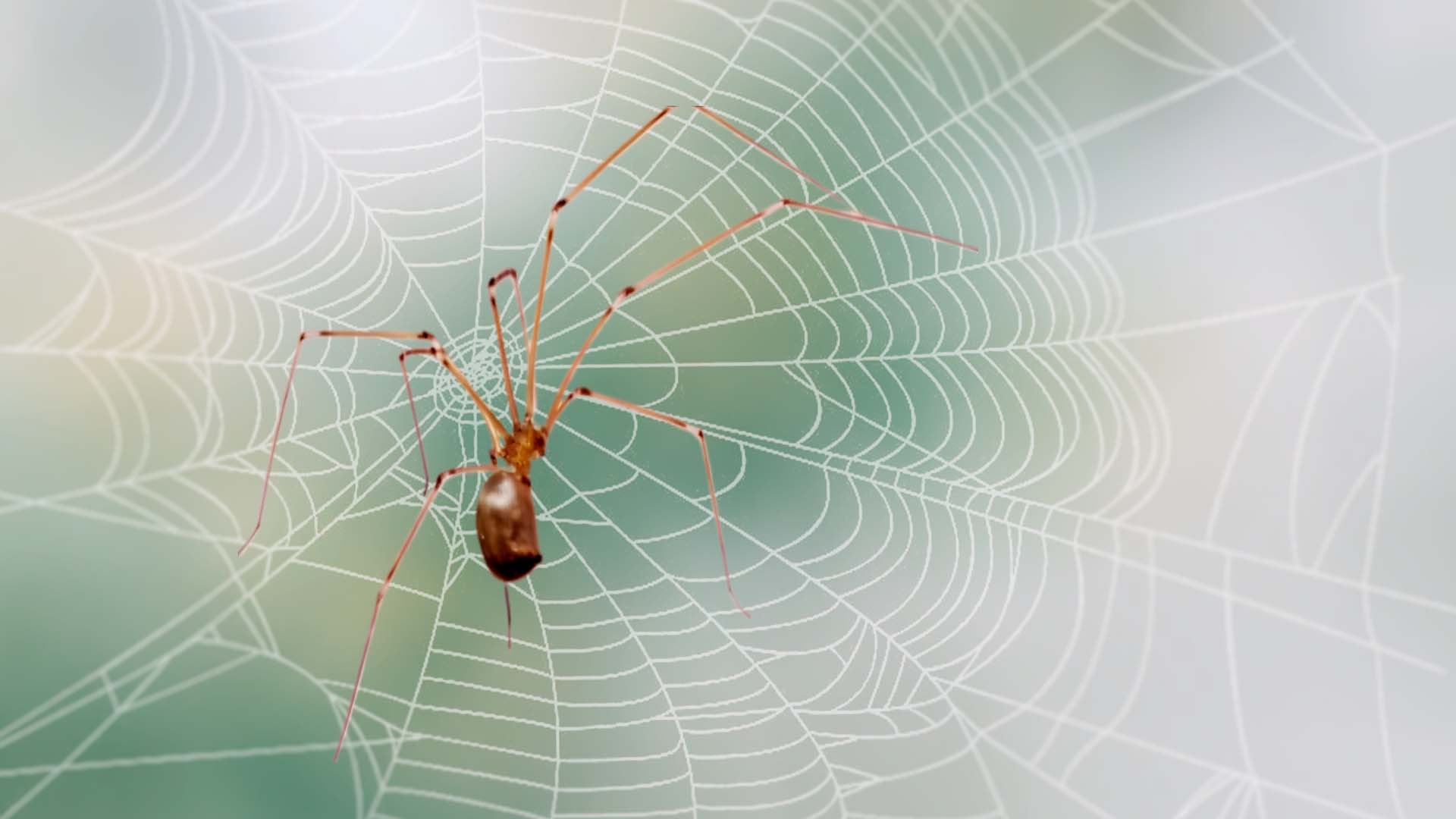
Can a Daddy Long Legs Bite Kill You (You Need to Know)
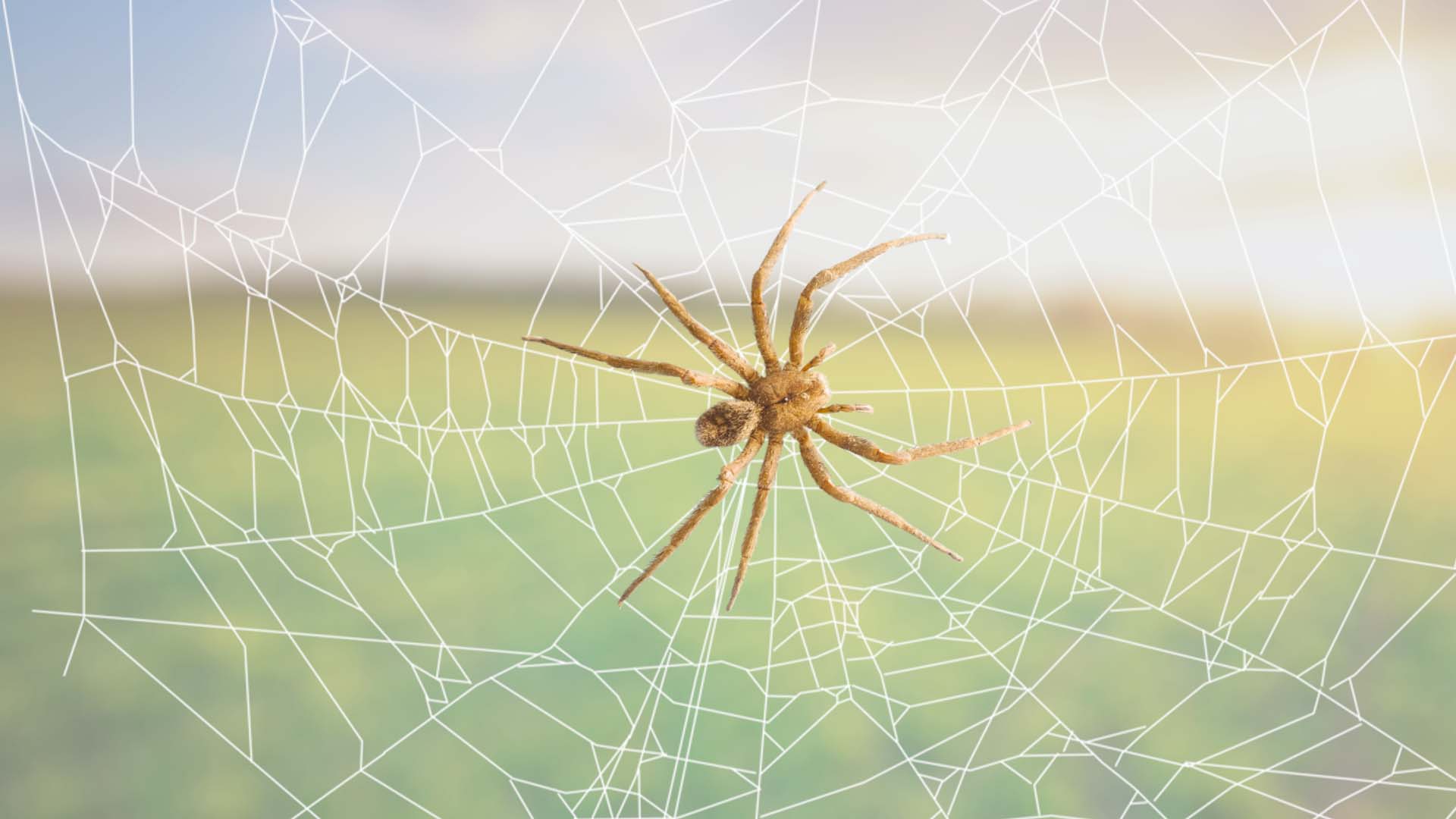
7 Facts About The Brazilian Wandering Spider
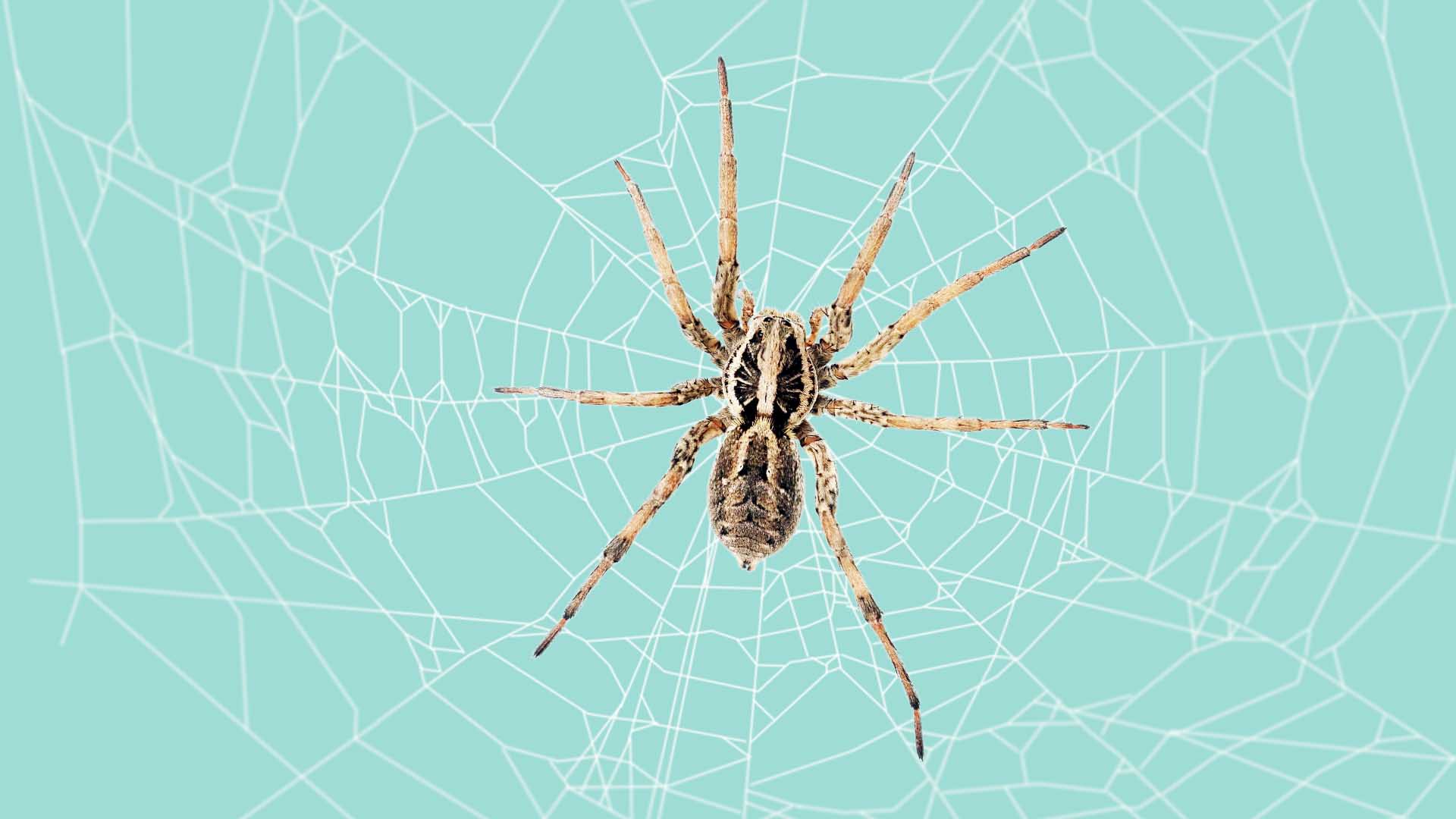
Are Wolf Spiders Poisonous for Humans, Cats or Dogs? (Explained)
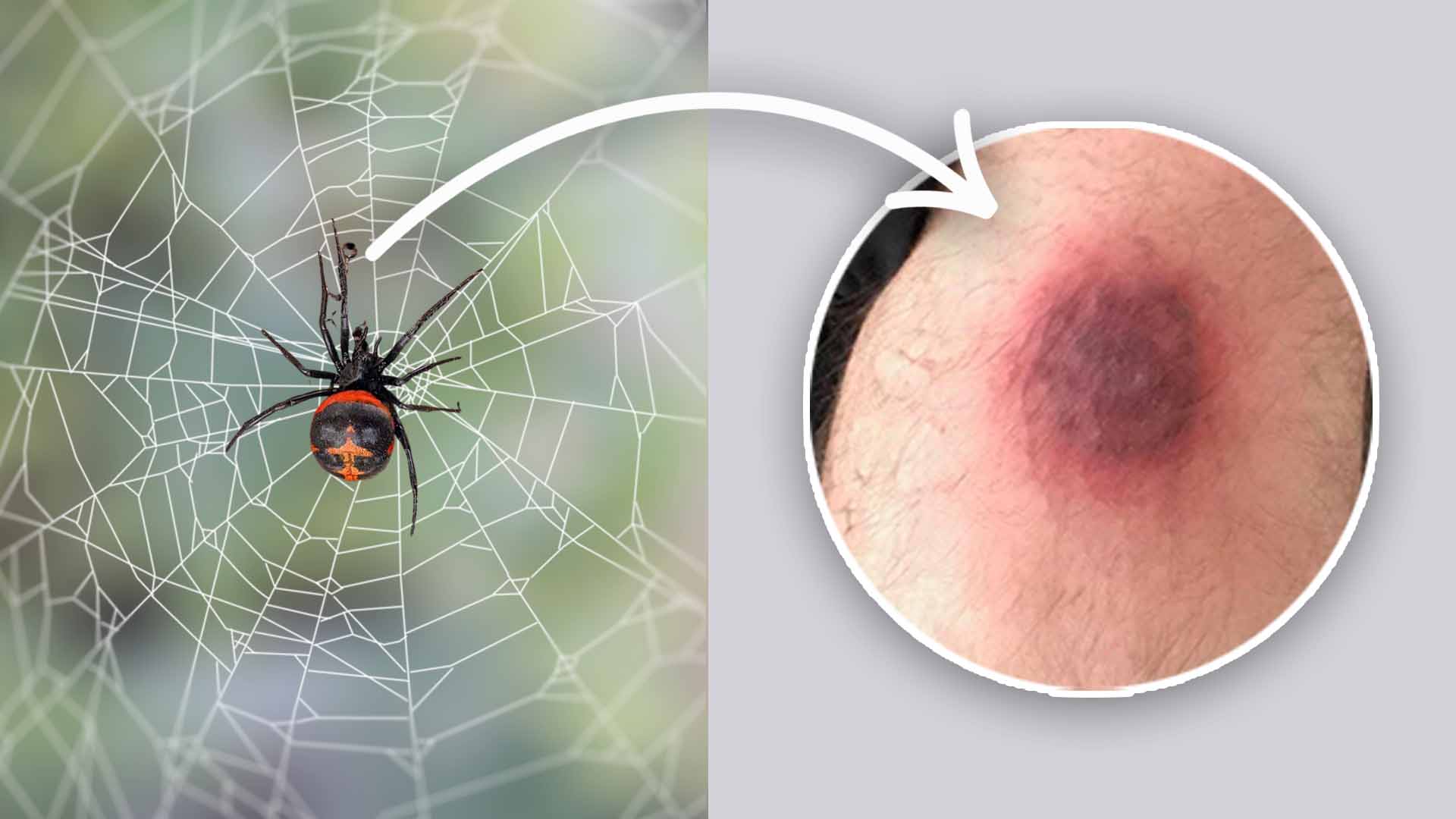
When To Worry About A Spider Bite? (Need to Know)

Press ESC to close
The brazilian wandering spider: threats and treatments.
Imagine being bitten by a spider that not only causes excruciating pain, but also induces a painful and prolonged erection. This peculiar arachnid is no other than the Brazilian Wandering Spider, a creature that strikes fear into the hearts of many. This article explores the threats posed by this venomous spider and examines the treatments available for its bite. Prepare to discover the terrifying world of the Brazilian Wandering Spider and the measures taken to combat its deadly effects.
Table of Contents
Overview of the Brazilian Wandering Spider
Introduction to the Brazilian Wandering Spider
The Brazilian Wandering Spider, scientifically known as Phoneutria, is a species of venomous spider found primarily in South and Central America, with Brazil being its native habitat. These spiders are known for their distinct hunting techniques, potent venom, and the ability to wander, hence their name. With its aggressive nature and potentially lethal bite, the Brazilian Wandering Spider poses a significant threat to humans and animals alike.
Preferred Habitat and Distribution
Brazilian Wandering Spiders are adaptable creatures that can thrive in various habitats, ranging from tropical rainforests to urban areas. They prefer dark and secluded areas like tree stumps, piles of leaves, and crevices, typically found in the wilderness. However, due to deforestation and human encroachment, these spiders have also adapted to urban environments, often found hiding in woodpiles, sheds, and even inside homes.
Physical Characteristics
The Brazilian Wandering Spider is a large arachnid, with a leg span that can reach up to 6 inches. They have a brownish appearance with darker markings, aiding in their camouflage amidst bark and leaves. These spiders possess strong legs, enabling them to move quickly and gracefully. The most distinguishing feature of the Brazilian Wandering Spider is their characteristic defensive posture, where they raise their front legs to display their fangs.
Behavior and Hunting Techniques
Unlike most spiders that build webs for hunting, Brazilian Wandering Spiders are active hunters. They spend their nights on the move, searching for prey and avoiding potential predators. These spiders have excellent eyesight and rely on their acute senses to detect movements and vibrations. When hunting, they employ a unique technique known as “lurking,” where they stay hidden, waiting for their prey to approach before quickly pouncing on it.
Diet of Brazilian Wandering Spiders
Brazilian Wandering Spiders have a varied diet, which includes insects, small rodents, and even lizards. Their venomous bite immobilizes their prey, making it easier for the spider to handle and consume. While they primarily feed on live prey, these versatile spiders can also scavenge for food when necessary, increasing their chances of survival in harsh environments.
Venomous Threats Posed by Brazilian Wandering Spiders
Potency of brazilian wandering spider venom.
The venom of the Brazilian Wandering Spider is considered one of the most potent among spider species. It contains a neurotoxin called PhTx3, which affects the nervous system, causing severe pain, muscle spasms, and potentially life-threatening reactions. Due to its toxicity, the venom of this spider is not only harmful to humans but can also be lethal to animals, including pets.
Signs and Symptoms of Spider Bites
When bitten by a Brazilian Wandering Spider, the symptoms can vary depending on the individual’s sensitivity and the amount of venom injected. Common signs of spider bites include intense pain, redness, swelling, and local tissue damage. In severe cases, individuals may experience systemic effects like muscle cramps, increased heart rate, sweating, and even difficulty breathing. It is crucial to seek medical attention immediately if bitten by this spider.

Health Risks and Potential Complications
Being bitten by a Brazilian Wandering Spider can lead to various health risks and potential complications. The neurotoxic effects of the venom can cause paralysis, respiratory failure, and in extreme cases, death. Additionally, some individuals may develop allergic reactions to the venom, further exacerbating the severity of the bite. Prompt medical treatment is essential to minimize the risks and complications associated with these spider bites.
Comparison to other Venomous Spiders
Compared to other venomous spiders, such as the Black Widow or Brown Recluse, the Brazilian Wandering Spider’s bite is known to be more lethal due to its potent venom. While the Black Widow and Brown Recluse spiders are found in different regions, their venom can cause severe local tissue damage and systemic symptoms as well. Each spider species presents unique risks, and understanding their differences is crucial in providing appropriate medical treatment.
Fatalities and Incidents Reported
Fatalities related to Brazilian Wandering Spider bites are rare, thanks to the availability of antivenom and timely medical interventions. However, incidents of spider bites resulting in immediate hospitalization and severe complications have been documented. Particularly vulnerable to these bites are children, the elderly, and those with underlying health conditions. Prompt reporting and proper management of spider bites are crucial to prevent tragic outcomes.
Medical Treatments for Brazilian Wandering Spider Bites
Emergency response and first aid measures.
In the event of a Brazilian Wandering Spider bite, immediate action is necessary. First and foremost, it is essential to stay calm and seek medical help without delay. While waiting for medical professionals to arrive, follow basic first aid measures, including cleaning the wound with mild soap and water, applying a cold compress to reduce swelling, and keeping the affected limb immobilized to minimize venom spread.
Antivenom Administration for Spider Bites
Antivenom is the primary treatment for Brazilian Wandering Spider bites. It contains antibodies that neutralize the venom’s effects, reducing pain and preventing further complications. Medical professionals will carefully administer the antivenom, closely monitoring the patient’s vital signs and ensuring appropriate dosage. Antivenom therapy is vital in counteracting the potent neurotoxin and providing the best chance for a successful recovery.
Management of Pain and Swelling
To alleviate pain and reduce swelling associated with spider bites, various medications can be prescribed. Nonsteroidal anti-inflammatory drugs (NSAIDs) are commonly used to decrease inflammation and relieve discomfort. In some cases, opioids may be necessary to manage severe pain. Applying ice packs to the bite site and elevating the affected limb can also help reduce swelling.
Treatment Approaches for Systemic Effects
When systemic effects occur due to a Brazilian Wandering Spider bite, additional treatment approaches are required. Muscle relaxants and anticonvulsant medications may be administered to control muscle spasms and reduce the risk of convulsions. Supportive care, such as intravenous fluids and oxygen therapy, may also be provided to maintain hydration and ensure respiratory stability.

Long-Term Effects and Follow-Up Care
Even after the initial treatment of a Brazilian Wandering Spider bite, long-term effects may persist. Some individuals may experience residual pain, muscle weakness, or psychological trauma. Follow-up care is vital to monitor and manage any lingering symptoms. Physical therapy and counseling may be recommended to aid in rehabilitation and promote psychological well-being.
Prevention and Control Measures
Understanding spider behavior and habitats.
Understanding the behavior and habitats of Brazilian Wandering Spiders is crucial for effective prevention and control. Being aware of their preference for dark, secluded areas allows individuals to take proactive measures to minimize encounters. Regularly inspecting and cleaning potential hiding spots and sealing any gaps or cracks in homes and buildings can significantly reduce the chances of a spider infestation.
Spider Bite Prevention Tips
To prevent spider bites, adopting certain preventive measures is advisable. Avoid reaching into dark spaces without proper visibility, especially when gardening or working with woodpiles. Shake out clothing and shoes before wearing them, as spiders may seek refuge in these items. Using gloves when handling items in potential spider habitats can also provide a line of defense against accidental bites.
Safety Measures for Homes and Buildings
Creating a spider-free environment within homes and buildings can be achieved through implementing safety measures. Regularly clean and declutter living spaces, as spiders are attracted to dark and undisturbed areas. Installing screens on windows and doorways can prevent spiders from entering, and using weatherstripping to seal gaps will minimize entry points. Additionally, keeping outdoor lights off or changing the color to be less attractive to insects can also deter spiders.
Protective Clothing and Gear
When venturing into areas known for spider activity, wearing protective clothing and gear is essential to minimize the risk of bites. Long-sleeved shirts, long pants, and closed-toe shoes can provide a physical barrier between the spider and the skin. Additionally, using gloves, hats, and face shields can further protect vulnerable areas, reducing the chances of accidental bites.
Insecticides and Pest Control Methods
In cases where spider infestations become significant and pose a threat, the use of insecticides and professional pest control methods may be necessary. It is important to follow local regulations and recommendations when applying insecticides, as some may be harmful to humans and pets. Seeking the assistance of licensed pest control experts ensures effective treatment while prioritizing safety.
Research and Studies on Brazilian Wandering Spiders
Scientific studies and species classification.
Scientific studies play a crucial role in expanding our knowledge of Brazilian Wandering Spiders. Researchers conduct studies to better understand their taxonomy, behavior, and venom composition. Species classification helps identify specific variations within the Phoneutria genus, allowing for more targeted research and providing a foundation for conservation efforts.

Venom Extraction and Composition
Extracting and analyzing the venom of Brazilian Wandering Spiders is essential for developing effective antivenom and understanding the biochemical properties of the venom. Researchers aim to identify the specific toxins present, their mechanisms of action, and potential therapeutic applications. Studying venom composition can uncover valuable insights into the spider’s hunting strategies and aid in the development of novel pharmaceuticals.

Antivenom Development and Efficacy
Research on antivenom development focuses on improving the efficacy and safety of existing treatments. Scientists work to refine antivenom formulations, ensuring they neutralize the spider’s venom effectively. Testing the antivenom’s efficacy against various species of Brazilian Wandering Spiders is crucial to provide broad coverage and maximize the chances of successful treatment.
Environmental Impact and Conservation
Understanding the environmental impact of Brazilian Wandering Spiders is essential for effective conservation strategies. Research delves into the spider’s role in the ecosystem, its interactions with other species, and the potential consequences of population decline. By assessing their conservation status and identifying threats, scientists and policymakers can develop measures to protect this species and preserve its natural habitats.
Future Research Directions
As scientific advancements continue, future research on Brazilian Wandering Spiders will focus on areas such as genetic studies, venom evolution, and behavior analysis. Deepening our understanding of their genetics can provide insights into their adaptability and evolutionary history, aiding in conservation efforts. Additionally, studying behavioral patterns can enhance our ability to predict their movements and prevent human encounters.
Emerging Concerns and Cases of Brazilian Wandering Spider
Global spread and entry into new regions.
The global spread of the Brazilian Wandering Spider is a growing concern. Due to international trade and transportation, these spiders have been inadvertently introduced to regions outside their native habitat. Their ability to adapt to new environments increases the risk of establishing invasive populations, impacting local ecosystems and potentially posing a threat to human health.
Importance of Surveillance and Reporting
Surveillance and reporting systems are vital in monitoring and preventing the spread of Brazilian Wandering Spiders. Prompt and accurate reporting of potential sightings ensures swift action can be taken to mitigate the risks associated with these spiders. Encouraging public involvement and providing education on spider identification can help improve surveillance efforts and enable effective measures to be implemented.
Documented Cases Outside Brazil
While the Brazilian Wandering Spider is primarily found in Brazil, documented cases of encounters and bites have been reported in other countries. This highlights the potential for these spiders to establish populations beyond their native range and emphasizes the need for international cooperation in addressing this emerging concern. Sharing knowledge and experiences across borders is crucial in managing and preventing spider-related incidents.

Impact on Tourism and International Trade
The presence of Brazilian Wandering Spiders in areas heavily reliant on tourism and international trade can have significant economic implications. Fear of spider encounters and bites may deter tourists and affect the tourism industry. Moreover, the risk of transporting spiders through international trade, particularly in goods such as fruits or plants, poses a biosecurity concern that requires strict monitoring and prevention measures.
Legal and Regulatory Measures
To address the emerging concerns associated with the Brazilian Wandering Spider, legal and regulatory measures are necessary. Countries need to establish and enforce regulations on the import and export of potentially infested goods, ensuring adequate inspection protocols are in place. Collaboration between governments, organizations, and industries is crucial in establishing effective policies to minimize the risks posed by these spiders.
Interactions and Reactions from Local Communities
Fear and anxiety-related reactions.
The presence of Brazilian Wandering Spiders often elicits fear and anxiety among local communities. The aggressive behavior and potential dangers associated with these spiders contribute to a negative perception. Understanding the psychological impact of these fears is essential to develop educational programs and support services that address community concerns and promote emotional well-being.
Education and Awareness Programs
Educational initiatives and awareness programs play a vital role in mitigating the fears surrounding Brazilian Wandering Spiders. Providing accurate information about the spiders, their behavior, and the appropriate actions to take in case of encounters or bites can help alleviate anxiety and empower individuals to respond effectively. School programs, community workshops, and online resources are valuable tools to disseminate information and promote awareness.
Myths, Folklore, and Cultural Beliefs
Brazilian Wandering Spiders often find themselves entwined in myths, folklore, and cultural beliefs. Some local communities associate these spiders with superstitions and consider them to be omens or symbols of danger. Understanding these cultural beliefs and engaging in respectful dialogue is crucial to dispel myths, foster a better understanding of the spiders, and promote a harmonious coexistence.
Spider as a Symbol in Art and Media
The intriguing nature of the Brazilian Wandering Spider makes it a subject of fascination in art, literature, and media. Artists incorporate the spider’s image into various forms of expression, creating artwork that captures its mystique and intricate details. It serves as a reminder of the spider’s significance in both natural and cultural contexts, sparking conversations and encouraging further exploration.
Local Efforts for Spider Conservation
Communities residing in areas populated by Brazilian Wandering Spiders often play a crucial role in their conservation. Local conservation efforts may involve initiatives such as promoting sustainable land use, raising awareness about the importance of biodiversity, and establishing protected areas or nature reserves. Engaging local communities in spider conservation fosters a sense of ownership and shared responsibility for safeguarding these fascinating creatures.
Comparison with Other Dangerous Spider Species

Brown Recluse Spider
The Brazilian Wandering Spider and the Brown Recluse Spider both pose threats to humans, but they have distinct characteristics. While the Brazilian Wandering Spider is known for its wandering nature and highly potent neurotoxic venom, the Brown Recluse Spider is recognized for its reclusive behavior and venom that can cause necrotic skin lesions. Understanding the differences between these species is crucial in providing appropriate medical treatment for bites.
Black Widow Spider
Both the Brazilian Wandering Spider and the Black Widow Spider are venomous, but their venom composition and effects differ. While the Brazilian Wandering Spider’s venom primarily affects the nervous system, the Black Widow Spider’s venom contains neurotoxins that target the neuromuscular junctions. Recognizing the symptoms and seeking appropriate medical treatment are essential in managing bites from these spiders.
Sydney Funnel-Web Spider
The Brazilian Wandering Spider and the Sydney Funnel-Web Spider are both known for their potent venom and aggressive behavior. However, the Sydney Funnel-Web Spider is native to Australia, while the Brazilian Wandering Spider is found in South and Central America. Despite their geographical differences, both spiders require urgent medical attention in the case of bites due to the potential severity of their venom.
Redback Spider
The Redback Spider, native to Australia, is similar to the Brazilian Wandering Spider in terms of venom potency and potentially lethal bites. They both belong to the family of spiders known for their neurotoxic venom. While the Brazilian Wandering Spider is more active and known for its wandering behavior, the Redback Spider tends to build webs and wait for their prey. Understanding their distinct characteristics is essential in providing targeted medical treatment.
Taipan Spider
The Taipan Spider, also known as the Coastal Taipan or Australian Tarantula, is another venomous spider species found in Australia. Its unique venom composition makes it distinct from the Brazilian Wandering Spider. The Taipan Spider is known for its highly potent neurotoxic venom, but its behavior and physical characteristics differ significantly from those of the Brazilian Wandering Spider. Recognizing the differences helps in accurately identifying and managing spider encounters.
Misidentification and Popular Misconceptions
Confusion with harmless spider species.
Spider misidentification is a common occurrence, leading to unnecessary panic and fear. The Brazilian Wandering Spider may be mistaken for non-venomous species, such as harmless Huntsman or Wolf spiders, due to a superficial resemblance. Educating the public about distinguishing features and encouraging accurate identification can prevent unnecessary concern and promote a better understanding of these spiders.
Spider Hoax and Urban Legends
Urban legends and hoaxes involving spiders, including the Brazilian Wandering Spider, have contributed to public misconceptions. Sensationalized stories on social media or unreliable sources often exaggerate the dangers associated with these spiders, perpetuating unnecessary fears. Encouraging critical thinking and relying on reputable sources for information can help dispel myths and prevent the spread of false information.
Exaggerated Claims and Sensationalism
Exaggerated claims and sensationalism in media portrayals of the Brazilian Wandering Spider can contribute to public hysteria. Highlighting the spiders’ aggressive behavior and potential lethality without providing accurate context can create unnecessary panic. Promoting responsible journalism that presents factual information and provides balanced perspectives is essential to ensure accurate public understanding of these spiders.
Social Media Impact on Public Perception
Social media platforms have a significant influence on public perception and understanding of the Brazilian Wandering Spider. Misinformation can spread rapidly, contributing to fear and misunderstanding. It is crucial to encourage responsible sharing of information, verify facts before sharing, and promote scientific literacy to combat the spread of inaccuracies and ensure accurate portrayals of these spiders.
Expert Clarifications and Reliable Sources
Experts and reliable sources play a vital role in clarifying misconceptions surrounding the Brazilian Wandering Spider. Educating the public about the spiders’ behavior, venom potency, and risks through reputable sources is crucial. Scientists, researchers, and medical professionals can provide accurate and evidence-based information, addressing concerns and dispelling myths surrounding these spiders.
Conservation Efforts and Habitat Protection
Need for conservation initiatives.
Conservation initiatives are crucial to protect the Brazilian Wandering Spider and its natural habitats. The preservation of biodiversity, including these unique arachnids, is essential for maintaining healthy ecosystems. By recognizing the ecological importance of spiders and their role in pest control, conservation efforts can be integrated into broader strategies aimed at preserving the planet’s biodiversity.
Preserving Natural Habitats
Preserving the natural habitats of Brazilian Wandering Spiders is paramount to their long-term survival. Protecting forests, wetlands, and other ecosystems ensures the spiders have suitable areas to thrive. Implementing sustainable land use practices and conservation policies that consider the needs of these spiders and their habitats can help safeguard their populations for future generations.
Captivity Breeding Programs
In certain cases, captivity breeding programs may be established to support the conservation of Brazilian Wandering Spiders. These programs provide controlled environments for breeding and rearing these spiders, ensuring genetic diversity and maintaining healthy populations. Collaboration between reputable institutions and regulatory bodies is crucial in developing and implementing successful breeding programs.
Community Involvement in Spider Protection
Engaging local communities in spider protection efforts fosters a sense of responsibility and promotes the overarching goal of conservation. Encouraging the participation of local residents in monitoring spider populations, reporting sightings, and supporting sustainable land use practices can enhance the effectiveness of conservation initiatives. Community involvement ensures that the conservation efforts reflect the needs and values of the people living in close proximity to these spiders.
Role of Zoos, Sanctuaries, and Research Institutions
Zoos, sanctuaries, and research institutions play a vital role in the conservation of Brazilian Wandering Spiders. These establishments provide controlled environments for the spiders, conduct research, and educate the public. By supporting scientific studies, raising awareness, and participating in breeding programs, these institutions contribute to the long-term conservation of these fascinating arachnids.
In conclusion, the Brazilian Wandering Spider, with its potent venom and unique hunting techniques, poses both a venomous threat and an ecological fascination. Understanding its behavior, venom, and appropriate medical treatments is crucial in mitigating risks associated with potential encounters. Conservation efforts, public education, and responsible reporting play essential roles in preserving the natural habitats of these spiders and dispelling myths surrounding them. By promoting a better understanding of the Brazilian Wandering Spider, we can foster a sense of coexistence and ensure the well-being of both humans and these remarkable arachnids.
Share this:
Mike Benkert
I'm a bug enthusiast and creator of BugsWorldWide, a blog sharing his 15 years of my experience caring for bugs. I've traveled the world bird watching and I'm committed to helping others with bug care. Contact me at [email protected] for assistance.
The Art of Life Organization
Understanding the behavior of juvenile silverfish, recent posts.
- Do Grasshoppers Have Backbones
- Pet Scorpion Species
- Moth Wing Patterns
- Insect Photography
- Beetle Larvae
- Grasshopper Species
- Cricket Anatomy
Discover more from BugsWorldWide
Subscribe now to keep reading and get access to the full archive.
Type your email…
Continue reading

A home for Tarantula, Spider, Scorpion and Arachnid Enthusiasts.
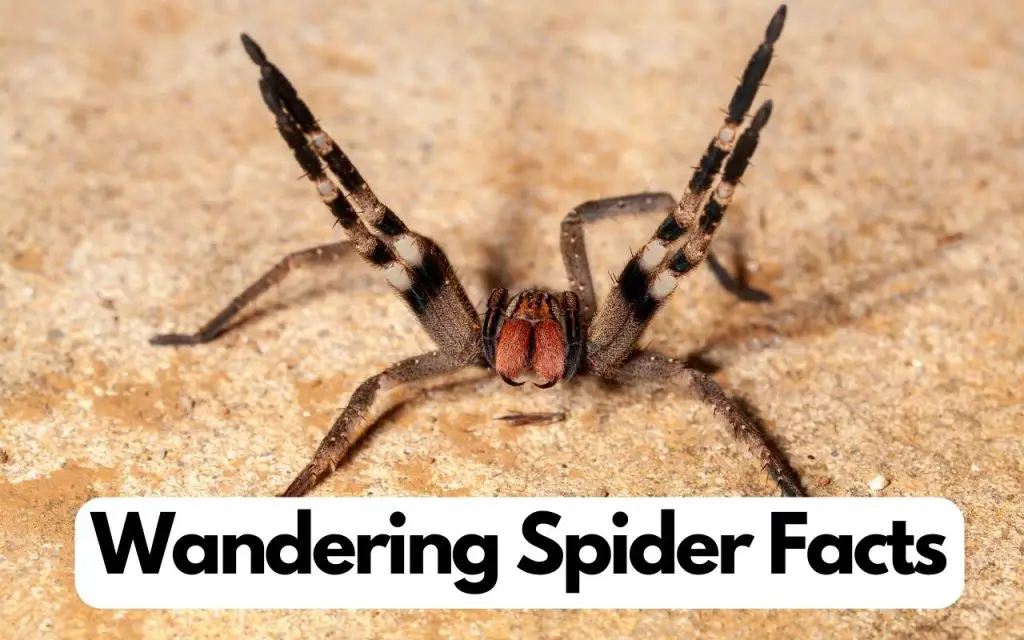
Brazilian Wandering Spider facts
Last updated on July 12th, 2023 at 01:48 pm
When you think of deadly spiders, there are a few names that spring to mind – but none more infamous than the Brazilian Wandering Spider. This species is reputed to have the most toxic venom of any spider, having a bite which causes horrendous side-effects like priapism and convulsions.
What you may not know, however, is that the Brazilian Wandering Spider name is actually used for a few species. The most common, and perhaps the most medically significant in the group are Phoneutria nigriventer and Phoneutria fera .
In this post, I’ll tell you more about these two species, from where they live, to what they eat. To keep things simple, I’ll just refer to them both as the “Brazilian Wandering Spider”, given how similar they are. Let’s dive in…
Quick Facts
To kick things off, here are some fascinating factoids about the Brazilian Wandering Spider:
- They belong to the genus ‘Phoneutria’, which translates to ‘murderess’ in Greek.
- They are known for their highly potent venom.
- Wandering Spiders are nocturnal creatures.
- They are also known as ‘banana spiders’ due to their tendency to hide in banana plants.
- They are not web-weavers but active hunters. This is called ‘cursorial’ hunting.
- It’s considered one of the most dangerous spiders in the world.
Other Common Names
The Brazilian Wandering Spider goes by several other names. The most common is the ‘banana spider’, thanks to their notorious habit of stowing away in banana shipments. In their native Portuguese, they’re known as ‘aranhas-armadeiras’ , translating to ‘armed spiders’ – a reference to their aggressive defense posture.
Brazilian Wandering Spider Venom
Possessing one of the most potent venoms among spiders, the Brazilian Wandering Spider’s bite is a cause for concern. Its venom is a complex cocktail of toxins, proteins, and peptides.
The main component that gets everyone’s attention is the neurotoxin, called PhTx3 , which can interfere with the functioning of our nervous system, leading to a variety of symptoms.
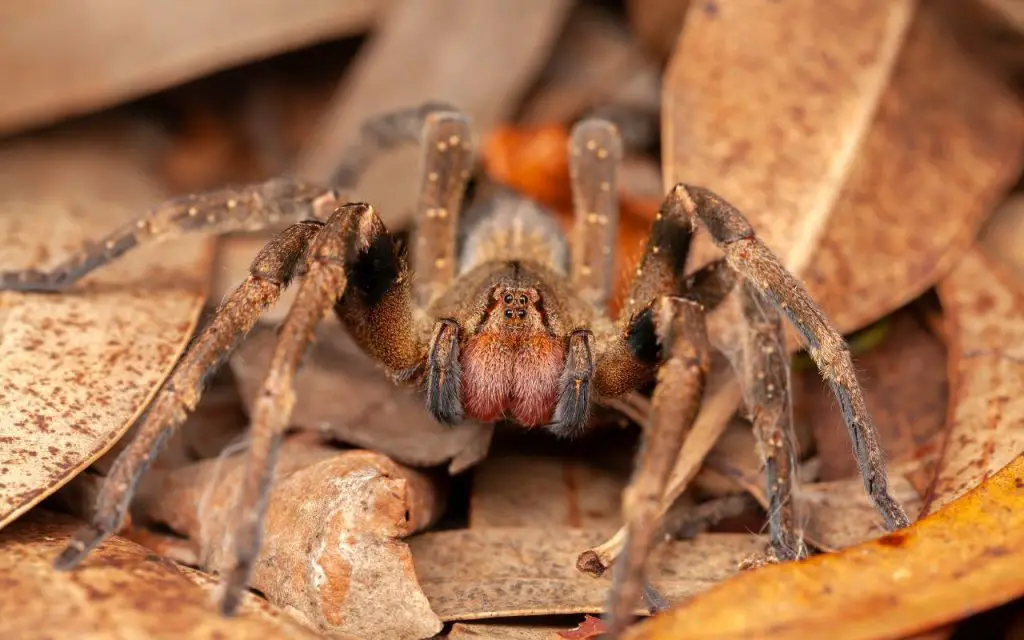
What’s the Benefit of Having Such Strong Venom?
With venom potent enough to kill a human, one might wonder why this spider needs such a powerful weapon. The answer lies in its lifestyle.
Brazilian Wandering Spiders are active hunters and their venom is primarily used to incapacitate prey quickly. The venom’s potency also serves as an effective deterrent against potential predators.
Brazilian Wandering Spider Deaths
Despite the notorious reputation, actual deaths from Brazilian Wandering Spider bites are rare. This is largely due to the rapid medical attention available in areas where these spiders are common. Plus, these spiders don’t always inject venom when they bite – a dry bite can occur.
This actually common in venomous animals, including spiders and reptiles. Occasionally they bite and decide to not inject any venom. The point of this is to conserve it, given that it is energetically costly to produce.
Brazilian Wandering Spider Size
Being quite large and impressive compared to most arachnids, adult Brazilian Wandering Spiders can reach a leg span of up to 7 inches (18 cm) . The body size excluding the legs can be up to 2 inches (5 cm). Their size contributes to their intimidating presence.
If you’d to learn more about why they get so big, check out my article on Brazilian Wandering Spider size for more info!
Brazilian Wandering Spider Location and Habitat
Brazilian Wandering Spiders are native to South America. Here’s a quick rundown of their range and preferred habitats:
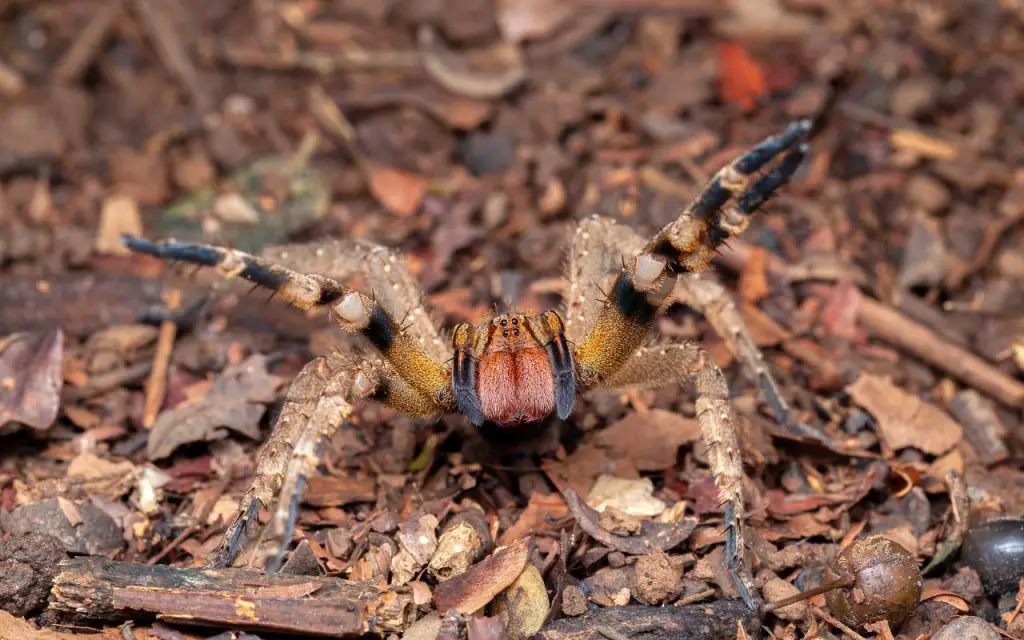
Brazilian Wandering Spider Speed
An adept hunter, the Brazilian Wandering Spider can move quickly when chasing prey or evading threats. While exact speed measurements can vary, some sources report that these spiders can achieve speeds up to 1 meter per second.
What Does the Brazilian Wandering Spider Eat?
The Brazilian Wandering Spider’s diet consists mainly of insects, other spiders, and occasionally small amphibians and reptiles. Their potent venom allows them to tackle prey larger than themselves, making them one of the apex micro-predators in their habitat.
Final Thoughts…
While the Brazilian Wandering Spider might seem terrifying to many, as an arachnid enthusiast, I find them to be incredibly fascinating. Their potent venom, hunting prowess, and adaptation to diverse habitats reveal the intricate beauty of the evolutionary process.
Just remember, these spiders, like all creatures, play a vital role in our ecosystem. Respect, not fear, should be our response to these remarkable arachnids.
The truth is that most bites are accidental, but they do occur. The fact that so few deaths occur each year is a testament to the effectiveness of the antivenom that has now become widely available.
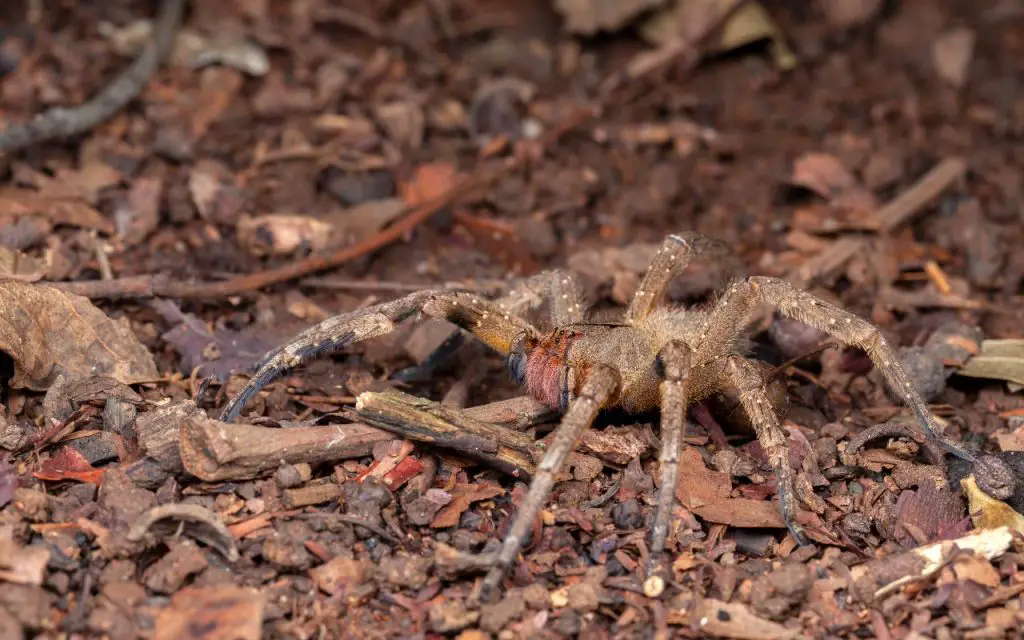
FAQ related to the Brazilian Wandering Spider
What happens if you are bitten by a brazilian wandering spider.
Immediately after a bite from a Brazilian Wandering Spider, you will experience localized pain. Then, within 5 to 15 minutes the area around the bite will swell. The swelling can spread to most of a limb, for example. Finally, neurological symptoms like coldness, sweating, and convulsions will set in.
Do wandering spiders jump?
Wandering Spiders are excellent at jumping. They can jump several feet when surprised, and may occasionally use this as a tactic to evade predators. Jumping at you isn’t part of how bites happen though. When faced with humans, Wandering Spiders usually stand their ground and use their threat display of raised legs to warn us away.
Is Brazilian wandering spider friendly?
Wandering Spiders are not friendly. As a general rule, they are relatively calm, but can also be defensive. They tend to see humans as a threat, and will not take to being handled easily. That said, they are not aggressive, and most bites happen when someone accidentally touches one or tries to kill it.
Are Brazilian wandering spiders in Australia?
Brazilian Wandering Spiders are not found in Australia. The only species in Australia that get as large as Wandering Spiders are the Huntsman Spiders. At a distance they may appear relatively similar, but Huntsman Spiders are completely harmless to humans.
Related Posts:
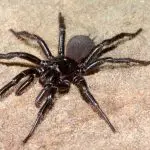
Leave a Comment Cancel Reply
Your email address will not be published. Required fields are marked *
Save my name, email, and website in this browser for the next time I comment.

Do Brazilian Wandering Spiders Bite?
Yes, the Brazilian Wandering Spider does bite. This arachnid species is known for its aggression and is considered one of the most poisonous spiders in the world.
A bite can cause severe medical conditions including intense pain, loss of muscle control, and difficulty breathing, although antivenom is available for treatment.
Can Brazilian Wandering Spider Bite Through Clothes?
Brazilian Wandering Spiders possess strong, potent fangs that are capable of biting through some lightweight or thin materials, which may potentially include certain types of clothing.
However, the likelihood of a bite penetrating thicker fabrics is less probable. Thus, while possible, it's not guaranteed that a bite would be able to penetrate all clothing materials.
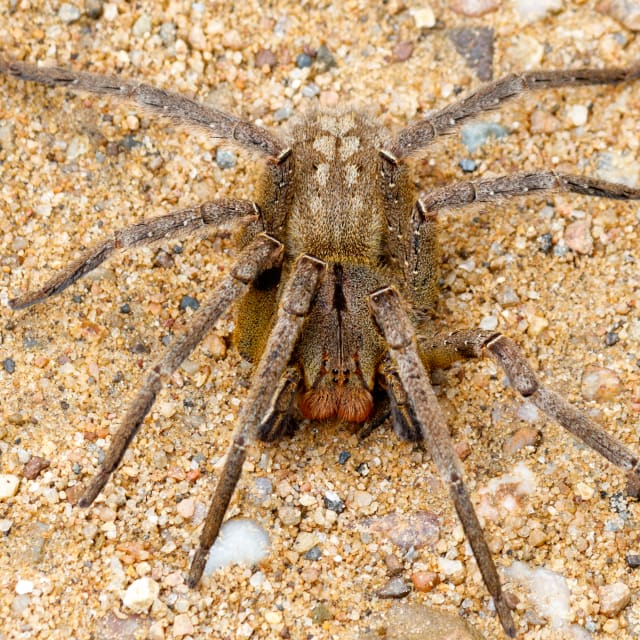
Do Brazilian Wandering Spider Bites Hurt?
Furthermore, if not treated promptly, the spider's venom can cause more severe symptoms, including sweating, high blood pressure, and even heart problems. It's important to seek medical help immediately after a bite.
FAQs about Brazilian Wandering Spider Bites
1. do brazilian wandering spiders bite or sting.
Yes, Brazilian Wandering Spiders do bite, they do not sting.
2. Do Brazilian Wandering Spiders bite humans?
Brazilian Wandering Spiders do bite humans.
3. Are Brazilian Wandering Spider bites dangerous?
Yes, Brazilian Wandering Spider bites are dangerous. They are considered to be one of the most venomous spiders in the world.
4. What happens if a Brazilian Wandering Spider bites you?
If a Brazilian Wandering Spider bites you, you may initially experience severe pain and swelling, followed by other symptoms such as sweating, high or low blood pressure, tachycardia, and blurred vision. If untreated, the venom can be life-threatening.
Also check:
Other Bugs' Bites
Check information about other bugs and learn if they bite or not and what you should do in case they bite.
Brazilian Wandering Spider Profile
Check the profile of Brazilian Wandering Spider and learn more interesting information about them.
Brazilian Wandering Spider Facts: What Happens If It Bites You?
Brazilian wandering spiders belong to the genus Phoneutria and are represented by eight spider species that are native to Central America and South America. This spider group is also collectively known as armed spiders and banana spiders. In Brazil, they are locally known as "aranha armadeira" which means armed spider. With these, some people often wonder if a person can survive after being by a member or species of this group.
What is a Brazilian Wandering Spider?
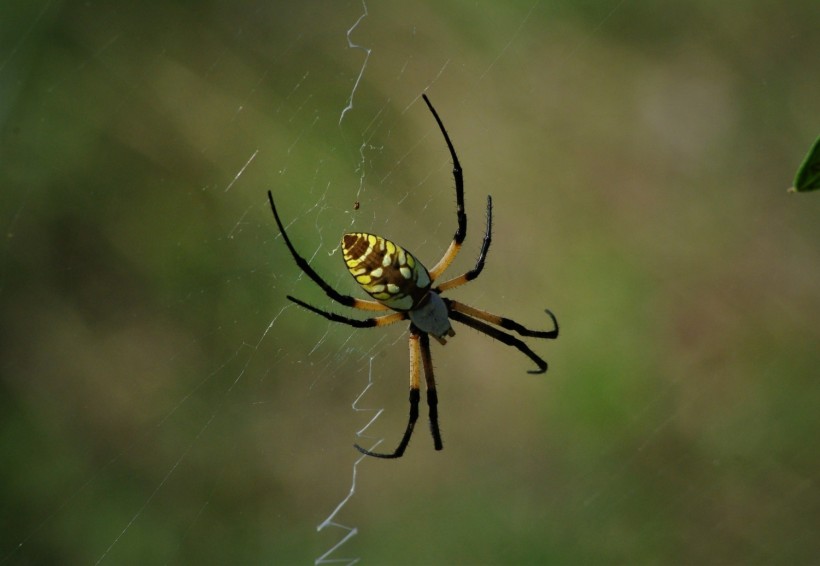
The genus Phoneutria , which the Brazilian wandering spider and related spider species belong to, was first described in 1833 when two species was included on it. The following century saw various scientists to move the Phoneutria species between genera Phoneutria and Ctenus . In 1936, Mello-Leitao restored Phoneutria and currently contains eight species, as reported by the University of Florida.
Banana spiders, a name given to the arachnid group due to their frequent presence on banana leaves, are large and robust arachnids in the family Ctenidae . They resemble the morphological appearance of wolf spiders. In addition, their body length can grow ranging from 17 and 48 millimeters and their leg span can reach 180 millimeters. Their distinct color ranges from light brown, brown, or grey. Furthermore, the natural habitats of armed spiders are forests.
Also Read: Deadly Erection-Giving Spider Crawls Out of Banana In Bristol
What Happens If It Bites You?
The natural prey of Brazilian wandering spiders includes small animals like crickets, mantids, and katydids, and larger ones like bats, frogs, and lizards. However, they can still bite humans and other animals not native in their habitats. In the past, scientists have identified that the bite of banana spiders living in Central and South American rain forests can lead to shortness of breath and excessive salivation.
According to wildlife experts, a Brazilian wandering spider bite can also lead to other serious symptoms, including increased blood pressure, above-normal pulse, and unusual respiratory rate, as well as extreme pain, hours-long penile erection, and death, in some cases. These spiders inject neurotoxin venom to its bitten victim and can be deadly to humans, particularly for children. However, it is not the world's deadliest spider.
Venomous Spider
In a study published in the journal Frontiers in February 2023, researchers stated that the Brazilian wandering spider is amongst the world's most dangerous venomous spiders in the world. In Brazil, there have been an estimated 4,000 envenomation accidents of Phoneutria nigriventer spider species each year in Brazil. Additional symptoms were also observed, including blurred vision, priapism, and vomiting.
The armed spider only follows the world's most venomous spider, which according to the Guinness World Records , is the Sydney funnel-web spider ( Atrax robustus ).
Like the Brazilian wandering spider, the venom of A. robustus can be neutralized by anti-venoms but some cases still lead to deaths when these arachnids bite a human, who did not receive any medical attention. Experts also weigh that the mortality of venom depends on the amount that enters a human body.
Related Article: Arachnophobia Nightmare: Giant Spider Found Inside Banana Box at Grocery Store in Germany
Tags Brazilian wandering spider , banana spider , Spider , spider bite , animals , Wild Animals
© 2024 NatureWorldNews.com All rights reserved. Do not reproduce without permission.

Plains Weather Outlook: Flooding Rain, Hail to Hit Oklahoma City, Dallas This Weekend

Archaeologists Uncover Nine Large Graves Containing Remains of Horses Dated Back 2,000 Years Ago

Amid Emerging 'ESG Fatigue' Questions, Mining Industry Leaders Moving Agenda Forward

Oklahoma to Texas Forecasts: Late Spring Weather Pattern to Unleash Heavy Rains, Localized Flooding
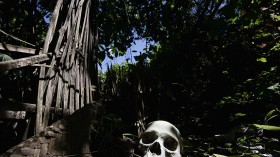
4,000-Year-Old Egyptian Skull Provides Clues to Historical Cancer Practices

Fact Animal
Facts About Animals
Brazilian Wandering Spider Facts
Brazilian wandering spider profile.
There are more than 50,000 species of spider, and the vast majority are less dangerous than a honeybee. Almost none are aggressive, and of those with medically significant venom, only a small percentage are capable of causing death. So, on the whole, arachnophobes are just being a bit silly.
But there’s one spider that vindicates all of these fears, and few animals are as globally renowned to be a serious threat to human lives as the Brazilian Wandering Spider .
Brazilian Wandering Spiders are actually 9 species of spider in the same genus ‘Phoneutria’, one of which is found in Central America, with the rest in South America.
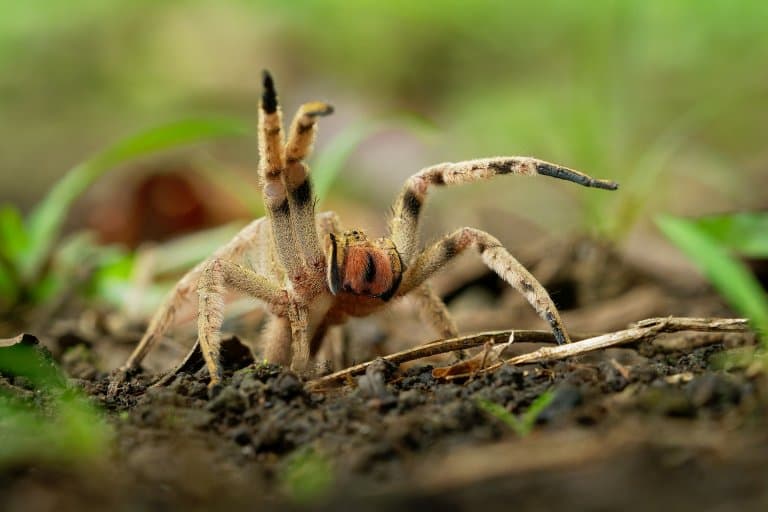
Brazilian Wandering Spider Facts Overview
These spiders are called wandering spiders because of instead of spinning a web to wait for food, or occupying a lair, they spend their night wandering in the leaf litter of the jungle floor for prey.
The sensitive hairs on its body help detect vibrations of passing prey, and it will feed on insects, lizards, frogs and any animals as large as itself.
During the day they will hide under logs, rocks, or inside termite mounds and banana plants. They will also sometimes wander into urban areas and homes, where they can come into contact with humans.
Brazilian wandering spiders are aggressive , dangerous and frightening. For once, this is an animal you should be wary of.
The females are larger, around 50% heavier than males, and produce more venom, and this might be a clue as to why their Greek name translates to “ Mudress” . These spiders will often stand and fight and have an intimidating threat display.
The potency of their venom is one of the reasons they’re so dangerous, and their ability to hide away in fruit and shoes explains why most bites are on extremities.
Interesting Brazilian Wandering Spider Facts
1. armed spiders.
In Brazilian, these are sometimes known as armed spiders, on account of their elongated front legs.
They can convey quite a bit of information with these legs, and as wandering spiders, use them to get about the forest, looking for food.
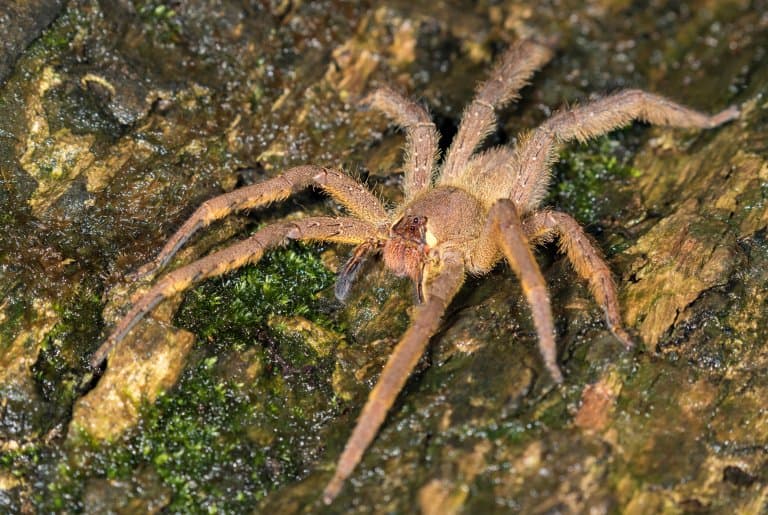
2. Banana Spiders
They’re also sometimes called ‘banana spiders’ on account of their status as a stowaway on popular fruit imported from the tropics.
This is becoming less common as stricter regulations ensure there’s less contamination of fruits, but there’s always a chance your next bunch of bananas will have a family of these spiders living inside it.
3. They have the largest venom glands of any spider
Females produce more venom than males, but both sexes have enormous venom glands. These glands are even more impressive when you consider the size of the spider is significantly less than the largest around.
The venom glands of the Brazilian Wandering Spider are over a centimetre long, and this is all housed inside the bright red chelicerae (mouth parts) which they are quick to display whenever they get upset. 1
4. They’re aggressive
These spiders can grow quite large and have long, brightly-coloured legs. Unlike most spiders, they’re known to stand their ground when threatened and are far quicker to bite than many other species.
They’ll still try to scurry away where possible, and they’re not out to get anybody.
But where most other species will flee, the wandering spiders’ aggression does make it more likely to be involved in incidents.
Most bites are on fingers and toes, a sign that they’re being stepped on or grabbed inadvertently. When the spider feels cornered, it’ll rear up on its back legs and waves its colourful arms around as a warning.
Then it’ll sway side to side, beckoning you to have a go. Anything foolhardy enough to call this bluff gets a wealth of envenomation effects. 2 3
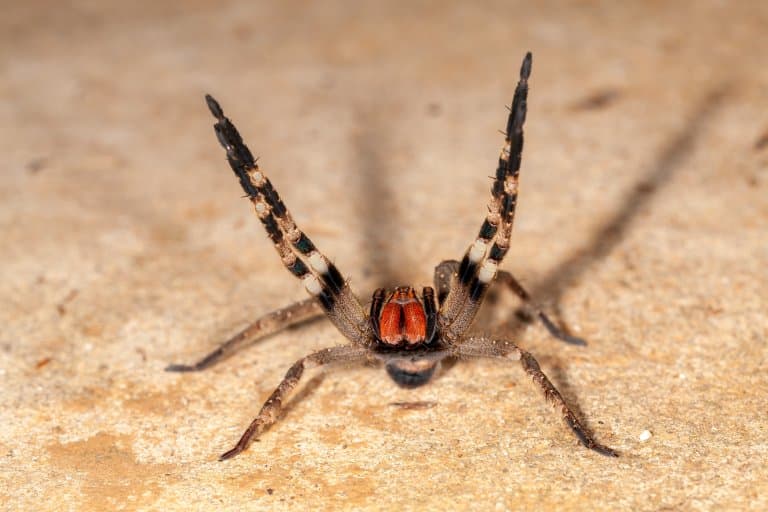
5. They give some men erections
There are ways to accomplish this with fewer side effects, but a bit from a Brazilian wandering spider does come with a certain Viagral quality.
This isn’t as fun as it might sound. Prolonged erections in this manner are likely to harm and destroy muscles and blood vessels in the penis and could cause irreparable damage.
Besides this, the assault on the central nervous system that comes with envenomation by this spider doesn’t sound worth it. 4
6. And some people die
This assault brings with it a whole host of unpleasant symptoms. Seizures, foaming at the mouth, inability to speak, collapse, and a host of other miserable experiences.
Paralysis is possible, as is cardiac shock. Blood vessels can burst in the brain, or anywhere else, and in many cases, this can be enough to kill a person.
This spider has one of the most potent venoms of all, and there are multiple legitimate records of death as a result of bites.
7. But they’re rarely fatal
While the Brazilian wandering spider is potentially one of the most dangerous spiders in the world, there is some evidence to suggest it gives a dry bite, defensively.
This means that despite exceptionally toxic venom, the amount actually injected is less than some of the other contenders, and this is what makes it typically less lethal than the Australian funnel webs.
These spiders are classified as Dangerous Wild Animals and would therefore require a special permit to keep. Bites from wandering spiders are common in South America, but antivenom is often readily available, and they rarely result in death.
In most cases, lethal bites are cases of a very young or very old victim, and few people of healthy age are killed. 5
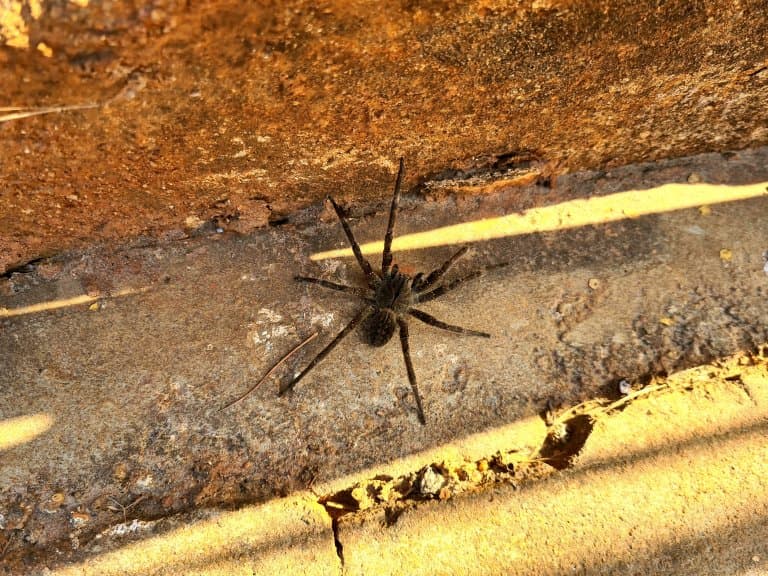
8. They do invade the UK sometimes
These unquestionably scary spiders show up in supermarkets in the UK on occasion, having hitched a ride on banana shipments.
On more than one occasion they’ve made their way into shoppers’ homes, but it doesn’t appear that there are any cases of them biting people as a result.
These spiders aren’t suited for temperate climates and don’t survive Winter, so there’s no risk of them multiplying.
Brazilian Wandering Spider Fact-File Summary
Scientific classification, fact sources & references.
- PeerJ. (2017), “ Dimensions of venom gland of largest venom glands in all spiders ”, Bio Numbers.
- Dave Clarke (2010), “ Venomous spider found in Waitrose shopping ‘beautiful but aggressive’” , The Guardian.
- “ Phoneutria Perty (Arachnida: Araneae: Ctenidae) ”, UF-IFAS University of Florida
- Kátia R.M. Leite (2012), “ Phoneutria nigriventer spider toxin Tx2-6 causes priapism and death: A histopathological investigation in mice ”, Science Direct.
- “ Brazilian wandering spiders: Bites & other facts ”, Live Science.

Brazilian wandering spider | bite,Size, Habitat, & Facts
Brazilian wandering spider.
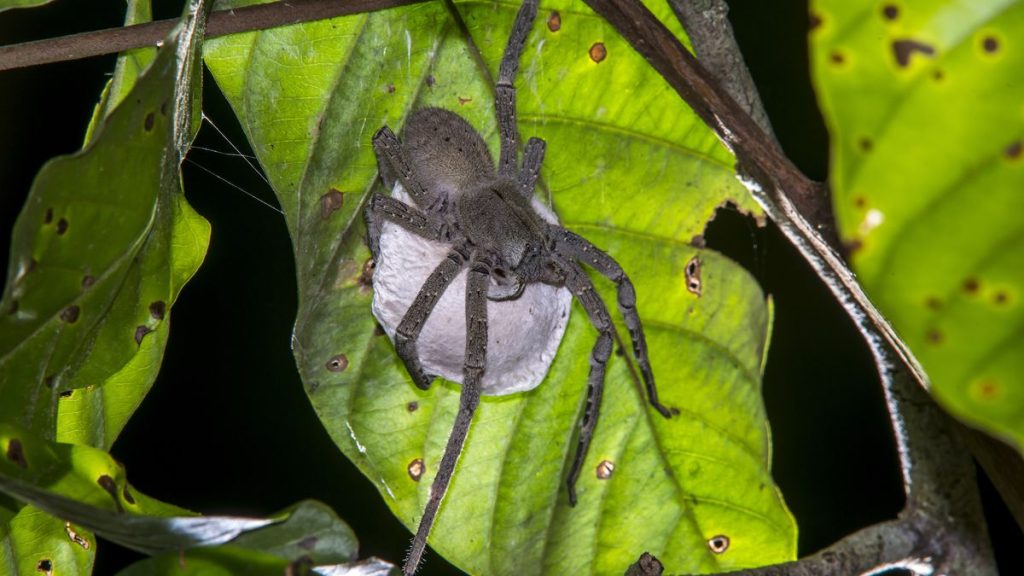
brazilian wandering spider size
Their body length ranges from 17 to 48 mm (43⁄64 to 1+57⁄64 in). Phoneutria are impressive spiders reaching body sizes up to 3.5 centimeters and leg spans up to 15 centimeters. They are nocturnal, hunting at night, and hiding in dark places during the day.
Wandering spider bite
Along with other members of the genus, they are often referred to as Brazilian wandering spiders. Its bite can cause severe symptoms, including increased pulse, blood pressure, and respiratory rate; extraordinary pain; penile erection that lasts for several hours; and, in several documented cases, death.
Phoneutria spp. is actually a genus with five known similar species whose members are highly venomous. They include some of the relatively few species of spiders that present a threat to human beings. The Brazilian Wandering Spider (Phoneutria fera) can grow to have a leg span of up to 4-5 inches.
Wandering spider, (family Ctenidae), any member of the family Ctenidae (order Araneida), a small group of large spiders of mainly tropical and subtropical regions, commonly found on foliage and on the ground.
The Brazilian wandering spiders, Phoneutria fera and P. nigriventer, are sometimes also referred to as banana spiders because they are frequently found on banana leaves. They have an aggressive defense posture, in which they raise their front legs straight up into the air. Phoneutria are venomous, and their venom is toxic to the nervous system, causing symptoms such as salivation, irregular heartbeat, and prolonged painful erections (priapism) in men. Scientists are investigating the venom of P. nigriventer as a possible treatment for erectile dysfunction.
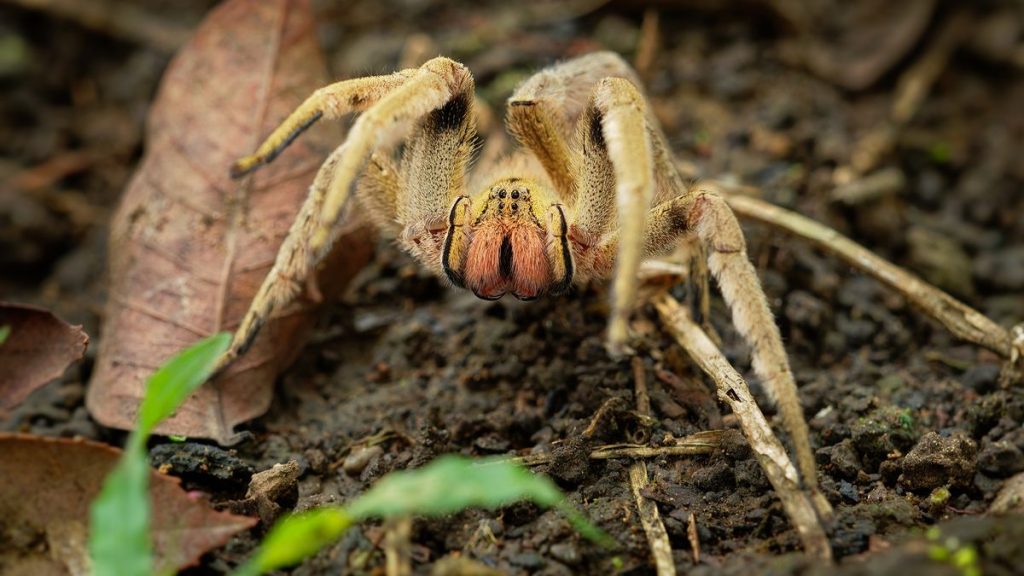
These spiders are notorious both due to their toxic venom, and because they are not reluctant to attack people who appear threatening.
Of the five species known, P. nigriventer and P. fera most frequently receive mention in mass-media publications. P.nigriventer species are responsible for most cases of venom intoxication in Brazil because this species is commonly found in highly populated areas of Brazil, namely the South-eastern states: São Paulo, Minas Gerais, Rio de Janeiro and Espírito Santo.The P. fera is native to the northern portion of South America, especially the Brazilian Amazônia, Venezuela and French Guiana.
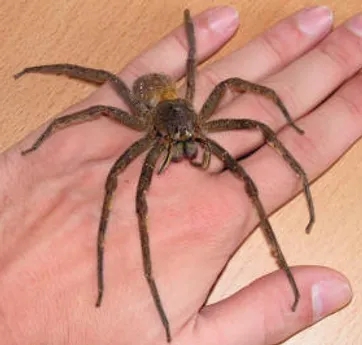
Brazilian wandering spider BITES AND VENOMB
razilian wandering spiders’ venom is a complex cocktail of toxins, proteins and peptides, according to the Natural History Museum in Karlsruhe, Germany. The venom affects ion channels and chemical receptors in victims’ neuromuscular systems.
After a human is bitten by one of these spiders, he or she may experience initial symptoms such as severe burning pain at the site of the bite, sweating and goosebumps, Sewlal said. Within 30 minutes, symptoms become systemic and include high or low blood pressure, fast or a slow heart rate, nausea, abdominal cramping, hypothermia, vertigo, blurred vision, convulsions and excessive sweating associated with shock. People who are bitten by a Brazilian wandering spider should seek medical attention immediately.
Recent studies suggest that these spiders only inject venom in approximately one-third of their bites and may only inject a small amount in another third. However, research in this area is hindered by the difficulty of identifying particular subspecies. Thus the effects of the bites from these spiders are hard to predict when based on sketchy information or if the spider has not been identified definitively.
Bites from these spiders may result in only a couple of painful pinpricks to full-blown envenomation. In either case, people bitten by a Phoneutria or any Ctenid should seek immediate emergency treatment as the venom is possibly life threatening.
he Phoneutria fera and nigriventer are the two most commonly implicated as the most virulent of the Phoneutria spiders. The Phoneutria not only has a potent neurotoxin, but is reported to have one of the most excruciatingly painful envenomations of all spiders due to its high concentration of serotonin.
Brazilian Wandering Spiders are extremely fast, extremely venomous, and extremely aggressive and are ranked among the most venomous spiders known to man. In fact, the Brazilian Wandering Spider is the most venomous spider in the New World! In South America, these true spiders are commonly encountered in peoples’ homes, supposedly hiding in peoples’ shoes, hats, and other clothes. It does not remain on a web, rather, it wanders the forest floor, which is how it got its name.
The Brazilian Wandering Spider has another name – the Banana Spider and it was given this name because there have been cases where these spiders unintentionally appeared on banana boats heading for the United States.
Brazilian Wandering Spider: One Of The World’s Most Venomous Spiders May Be Lurking In Your Bananas
Meet the Brazilian wandering spiders in the genus Phoneutria, also referred to as the armed spiders or the banana spiders. The members of this group have one of the most dangerous bites of any spider species on Earth and they have been classified as the world’s most venomous spider many times.
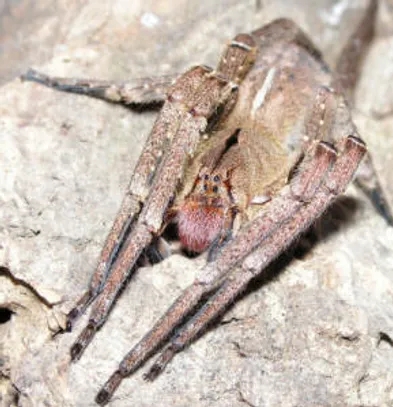
What Are The Effects Of A Brazilian Wandering Spider Bite?
Brazilian wandering spiders often make the news because of the unusual symptoms caused to humans after being bitten by one.
A 2023 study in Frontiers In Molecular Biosciences suggested there were around 4,000 cases of people being bitten by Phoneutria nigriventer in Brazil each year. Their venom affects the nervous system, causing double vision, salvation, irregular heartbeat – and even prolonged painful erections, known as priapism. In fact, because of this, their venom is being explored as a possible treatment for erectile dysfunction conditions.
Can A Brazilian Wandering Spider Bite Kill You?
The neurotoxin PhTx3 is to blame for these symptoms, and according to the Independent, a wandering spider bite can reportedly be fatal in as little as 60 minutes. However, an effective anti-venom is usually enough to save those affected. A study into Phoneutria boliviensis in 2019 suggested that the species had adapted its venom to catch vertebrates as opposed to lizards and amphibians, which might explain why the venom is so toxic to humans.
black and yellow garden spider
Brown recluse spider bite stages pictures.
This article is free to read if you register or sign in.
Simply register at no cost.
Questions or problems? Email [email protected] or call 0711 046 000 .
FACT CHECKER
Misleading: bite from brazilian spider causes four-hour erection, high or low blood pressure, fast or a slow heartbeat, nausea, abdominal cramping among signs..
• But Urologist Dr. Peter Mungai said penile erection involves neuron stimulation and production of hormones which has nothing to do with a spider bite.
• In addition to intense pain and possible medical complications, the bite of a Brazilian wandering spider can deliver a long, painful erection to human males because the venom boosts nitric oxide, a chemical that increases blood flow.
A viral photo claiming that a bite from a Brazilian spider causes an erection lasting up to four hours is misleading.
The photo, widely shared in WhatsApp groups, encouraged those with an erection disorder to try the spider to up their performance.
This came up following an online publication claiming that the species contains a possible breakthrough for erectile dysfunction.
“Most people who find a spider in their bedroom quickly try to get rid of it. But new research shows that one arachnid might actually be best kept by your bedside. A single bite from the Brazilian wandering spider has been shown to have side effects including a four-hour-long erection,” read part of the article.
But Urologist Dr. Peter Mungai said an erection occurs when a man becomes sexually aroused allowing hormones, muscles, nerves, and blood vessels to work together.
Mungai said penile erection involves neuron stimulation and production of hormones which has nothing to do with a spider bite.
“This is just a good joke because a spider cannot produce the hormones or neurons needed to stimulate a penile erection,” he said.
“If it is true that such information is doing rounds then it could be by some sadists who do not understand the mechanism of erection,” he added.
The neurons in these hypothalamic nuclei contain peptidergic neurotransmitters, including oxytocin and vasopressin, which may be involved in penile erection.
Several brain stem and medullary centres are also involved in sexual function.
For an erection to occur, nerve signals sent from the brain to the penis stimulate muscles to relax in turn, allowing blood to flow to the tissue in the penis.
Once the blood fills the penis and an erection is achieved, the blood vessels to the penis close off so that the erection is maintained.
Following sexual arousal, the blood vessels to the penis open up again, allowing the blood to leave.
However several studies here indicate that the Brazilian wandering spiders' venom is a complex cocktail of toxins, proteins and peptides which affects ion channels and chemical receptors in victims' neuromuscular systems.
The wandering spiders, also called armed spiders or banana spiders, belong to the genus Phoneutria, which means "murderess" in Greek. And it's no wonder why — it's one of the most venomous spiders on Earth.
After a human is bitten by one of these spiders, he or she may experience initial symptoms such as severe burning pain at the site of the bite, sweating and goosebumps.
Within 30 minutes, symptoms become systemic and include high or low blood pressure, fast or a slow heartbeat, nausea, abdominal cramping, hypothermia, vertigo, blurred vision, convulsions and excessive sweating associated with shock.
In addition to intense pain and possible medical complications, the bite of a Brazilian wandering spider can deliver a long, painful erection to human males because the venom boosts nitric oxide, a chemical that increases blood flow.
People who are bitten by a Brazilian wandering spider should seek medical attention immediately.
Several studies are looking at incorporating the venom into drugs for erectile dysfunction.
However, these bites are rare, and envenomations are usually mild.
The Star’s fact check concludes that while it is true a bite from this spider may cause an erection, it is a painful erection which is a disorder due to the venom.
The information is thus misleading.
Most Popular
South africa releases early results from pivotal poll, state is committed to tackling youth unemployment – ruto, uae provided private jet ruto used for us trip – state house, mudavadi: kenya kwanza wrangles not unique, focus still on, uda grassroots polls to proceed as planned – elections board, latest videos, management row at nyali school paralyses learning, sh300m spent on evacuation from riparian areas ruto, sign up for the free star email newsletter and receive the latest kenya news daily..
Spider-Man: 5 Weird Effects of Real Spider Bites
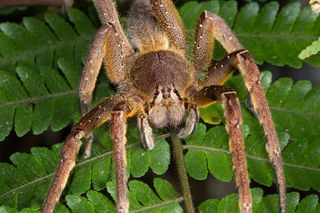
Although Spider-Man got his superhero abilities from a spider bite, ordinary spider-bite victims may have to deal with spider-bite effects that have nothing to do with being able to scale walls and climb around on ceilings.
Some of the weirdest effects that spider venom may have on regular, nonsuperhero humans include unwanted erections, dead skin tissue that turns black, unusual rashes, dark pee and sweat so heavy it makes puddles on the floor.
However, it is important to remember that such unusual symptoms are extremely rare, and the vast majority of spider bites are harmless, or cause only mild irritation and itchiness. [ In Photos: The Science of the Amazing Spider-Man 2 ]
In fact, spiders do not often bite people, and if they do, it is because they feel threatened. Black widow spiders and brown recluse spiders are the only two spider species in North America whose bites may sometimes result in symptoms more serious than minor local pain and swelling, according to Rick Vetter, a retired arachnologist at the University of California, Riverside.
Although hobo spiders, which are common in the Pacific Northwest, are also listed by the Centers for Disease Control and Prevention as one of the three types of spiders that can be toxic to people, some researchers have argued that hobo-spider venom may not be so toxic after all.
Here are some of the weirdest effects spider bites have had on people.
Venomous Viagra?
The Brazilian wandering spider's venom contains a toxin whose unusual erection-inducing qualities have attracted the attention of the pharmaceutical industry. In 2007, researchers found that the bites of the Brazilian wandering spider can cause long and painful erections in human males, along with other symptoms. The effect happens because the spider's venom raises the levels of nitric oxide, which is a chemical that increases blood flow.
Sign up for the Live Science daily newsletter now
Get the world’s most fascinating discoveries delivered straight to your inbox.
Researchers have since tested the toxin that is responsible for this unusual effect, called PnTx2-6, in the hope of developing a potential new drug for erectile dysfunction .
The Brazilian wandering spider is large, with a body size reaching up to 2 inches (5 centimeters) and leg spans stretching 5 or 6 inches (13 to 15 cm). Although the creepy crawler's size may make it look threatening, it is not aggressive and, like most spiders, will only attack when it feels threatened, experts say.
Dead tissue
Although there have been cases of "necrotic arachnidism," in which spider venom kills human tissue, such cases are extremely rare. In fact, researchers estimate that less than one case of dead human tissue is reported per 5,000 spider bites from verified spider specimens, and verification of spider bites is very rare, Dr. Scott Weinstein, a toxinologist at Women's and Children's Hospital in North Adelaide, South Australia, told Live Science. (Toxinology is the study of the venoms and poisons of plants, animals and microbes; it is different from toxicology, which is the study of chemicals and drugs as they affect the body.)
If a spider bite is "verified," it means that there was actual evidence that a person was bitten by a particular kind of spider. The only spider in North America whose bites have been shown to kill human tissue in rare instances is the brown recluse spider, Vetter said.
When necrosis does occur, tissue may sometimes turn black as cells die. One such case was reported last year — a woman on vacation in Italy developed necrosis in her ear after being bitten by a brown recluse spider. Part of her ear turned black, and her doctor had to remove the dead tissue and restore it, using cartilage from the woman's ribs.
Some people develop unpredictable skin reactions to spider bites . A 66-year-old patient in France developed a strange rash after being bitten by a spider, which the doctors suspected was likely a brown recluse spider, according to a report of his case. The man had pinhead-size bumps on his forearms, which later spread to other parts of his body.
The medical staff diagnosed the man with a condition called acute generalized exanthematous pustulosis (AGEP), which typically occurs in people taking antibiotics. Other reports have also linked AGEP to brown recluse spider bites, the researchers said. The man recovered in five days, after doctors treated him with oral corticosteroids.
Unusual blood disorders and dark pee
In the case of the man in France who developed the strange rash, the doctors also found that he had a blood disease called periarteritis nodosa (PAN), in which small arteries become swollen and damaged. The doctors linked his blood condition with the brown recluse bite, because previous reports had described conditions similar to PAN in animals injected with brown recluse spider venom.
In fact, blood disorders are some of the rare symptoms that occur in people who have been bitten by recluse spiders, Vetter wrote in one study. The brown recluse venom may cause red blood cells to burst and release their contents into plasma, in a process called hemolysis. As a result, anemia may develop and can last from four to seven days, he said.
These blood problems may lead to other symptoms, such as acute kidney injury and jaundice (yellowing of the skin), as the blood protein called hemoglobin breaks down. The waste products of the breakdown can build up in the blood, and turn the urine dark when they are then excreted.
Puddles of sweat
Some Australian widow spider bite victims have been found to sweat so much after getting bitten that their sweat formed puddles on the floor, Vetter reported in one study.
Excessive sweating is one of the symptoms that may result from the bites of certain spiders that affect the nervous system. The venom of the black widow, for instance, attacks nerves by blocking their signals to the muscles. This causes the muscles to contract repeatedly, which can be painful and stressful for the body.
Black widow spider bite victims may also experience other nerve-related symptoms, such as high blood pressure, restlessness and severe facial spasms.
Who gets these spider-bite symptoms?
Whether a spider bite affects a person only mildly or causes severe symptoms depends on a number of factors, such as the amount of the venom injected, and the size and age of the person who got bitten. Children and elderly people are particularly susceptible to extreme symptoms from toxic spider bites.
However, most people who get bitten are highly unlikely to experience these severe symptoms, researchers say.
Originally published on Live Science.
Giant, invasive Joro spiders with 6-foot webs could be poised to take over US cities, scientists warn
Diving bell spider: The only aquatic arachnid that creates a web underwater to live in
Meet LocoMan, the quirky robot dog that can stand up on its hind legs like a meerkat and play with objects
Most Popular
- 2 32 optical illusions and why they trick your brain
- 3 James Webb telescope sees 'birth' of 3 of the universe's earliest galaxies in world-1st observations
- 4 Space photo of the week: NASA sees a 'Platypus' move on Jupiter's moon Europa
- 5 Things are finally looking up for the Voyager 1 interstellar spacecraft
- 3 Ramesses II's sarcophagus finally identified thanks to overlooked hieroglyphics
- 4 Secrets of radioactive 'promethium' — a rare earth element with mysterious applications — uncovered after 80-year search
- 5 Auroras could paint Earth's skies again in early June. Here are the key nights to watch for.
Could Spider Venom Be the Next Viagra?
Researchers are studying the surprising side effects of the banana spider’s bite
/https://tf-cmsv2-smithsonianmag-media.s3.amazonaws.com/accounts/headshot/Rachel-Nuwer-240.jpg)
Rachel Nuwer
/https://tf-cmsv2-smithsonianmag-media.s3.amazonaws.com/filer/Wandering_spider-470.jpg)
A bite from the banana spider (also known as the Brazilian wandering spider) of Central and South American rain forests causes shortness of breath, excessive salivation, tremors and—for men—a persistent, intensely painful erection, known as priapism in the medical community.
So potent is this spider’s ability to command an erection that researchers wondered if it couldn’t be somehow transformed and used for good. According to WebMD , erectile dysfunction affects around 18 million men in the U.S. alone, and common treatments like Viagra, Levitra and Cialis fall short of providing results for one in three men with ED.
Scientists write in the Journal of Sexual Medicine that one of the banana spider’s toxins, PnTx2-6, helped elderly rodents with their ER, reports National Geographic News . The toxin triggered the release of nitric oxide, which increased circulation in the rats’ genitals and relaxed the relevant blood vessel walls. If rats and human men are anything alike, the researchers suspect treatments eventually derived from the toxin might help patients who fail to respond to drugs like Viagra, which relies on a different mechanism.
Banana spiders are not the only organisms found in nature with a particular penchant for bringing on unwanted erections. Rabies, too, sometimes has this effect. In 1988, doctors described the case of one such affliction in the Postgraduate Journal of Medicine :
A 47 year old male was admitted with the chief complaints of recurrent ejaculation and hydrophobia. The patient, who was fully conscious and lucid at the time of admission and gave us his own history, confirmed that that morning he had hypersensitivity of the penis manifesting as recurrent erection and ejaculation occurring at the slightest touch. The hypersensitivity was so exquisite that the mere touch of his underwear against his penis was enough to trigger off spontaneous erection and ejaculation.
The patient died, however, and fortunately there’s no talk in the scientific community of treating no-show erections with rabies.
More from Smithsonian.com:
Stick Bugs Have Sex For Two Months Straight Biology’s Ten Worst Love Stories
Get the latest stories in your inbox every weekday.
/https://tf-cmsv2-smithsonianmag-media.s3.amazonaws.com/accounts/headshot/Rachel-Nuwer-240.jpg)
Rachel Nuwer | | READ MORE
Rachel Nuwer is a freelance science writer based in Brooklyn.

15 Types Of Spiders, Ranked By Danger Level
I n the intricate web of the natural world, spiders are often painted as creatures of fear and danger. Yet, beneath the surface lies a reality often overlooked: spiders are typically shy and reserved beings, opting to avoid human interaction whenever possible. According to Kids Health , they only resort to biting when provoked or inadvertently trapped, contrary to the common misconception of them as aggressive predators.
When they do bite, spider bites, despite their notorious reputation, are generally harmless. While all spiders carry poison, not all spiders contain the glands necessary to deliver this poison to humans via bite. Technically, their poison would only cause harm to you if you ingested the spider. However, it's a different story when it comes to venomous spiders. These spiders do have the ability to inject humans with their venom via bites, and some venomous spiders possess toxins that can cause serious harm, leading to potentially severe consequences if not treated promptly.
While we might all freak out if we see bite marks on our bodies after recently encountering a spider, not all bites warrant a trip to the hospital. But some might. In this ranking, we'll explore 15 species of spiders, each with its unique level of danger if a bite were to occur.
Read more: 13 Creatures To Beware Of When Adventuring In California's Deserts
Cellar Spider
Pholcus phalangioides, also known as "daddy longlegs" or cellar spiders, belongs to the Pholcidae family. Recognized by their elongated legs and delicate appearance, they commonly inhabit dark, humid environments like basements, caves, and cellars, where they construct irregular webs to catch prey.
Cellar spiders are generally considered harmless to humans and typically display non-aggressive behavior. Preferring to avoid human contact, they are shy and reclusive creatures. Interestingly, they are beneficial as they contribute to controlling populations of other pests, such as flies and mosquitoes.
Despite their reputation, there are no documented cases of any pholcid spider biting humans and causing harm. However, a prevalent myth erroneously labels them as one of the most lethal spider species. This myth lacks scientific support, as the venom composition and potency of these spiders have never been formally studied. Studies indicate that if a person were to be bitten, the effects are usually mild and inconsequential. For instance, a 2019 study in Frontiers in Ecology and Evolution found minimal adverse reactions to bites from cellar spiders.
Common House Spider
The common house spider, scientifically known as Parasteatoda tepidariorum, is one of the most widespread and well-known spider species found in human habitats worldwide. Like daddy longlegs, these spiders are often encountered indoors, where they build irregular webs in corners, crevices, and other sheltered areas. However, they are distinguished by their darker ring-like pigmentation on their legs.
The threat level posed by common house spiders is minimal. They are not aggressive toward humans and are more likely to flee than bite when encountered. Additionally, their fangs are not well-suited for penetrating human skin, further reducing the likelihood of bites occurring. If one were to aggravate the common house spider so intensely that it does retaliate with a bite, their venom is relatively mild, rendering their bites typically harmless to humans (via Western Exterminator ). There has only been one case of a serious reaction to a bite by a common house spider, but this was because the victim was allergic (via the University of Florida IFAS ).
Yellow Sac Spider
The yellow sac spider, scientifically known as Cheiracanthium inclusum, is a globally distributed species found across various regions, including North America. These spiders are easily recognizable by their pale yellow to light green coloration. Despite their relatively lower profile compared to other spiders, yellow sac spiders have garnered interest due to their unique web-spinning behavior. Instead of the intricate webs commonly associated with spiders, they construct sacs using their silk, a behavior noted by Truly Nolen .
Regarding their potential danger to humans, yellow sac spiders are considered medically significant, although the extent of their threat remains a subject of debate. A study published in the American Journal of Tropical Medicine and Hygiene has shed light on this issue. The study discovered that in many cases where people thought yellow sac spiders caused severe reactions, subsequent searches didn't find any of these spiders nearby. The researchers suggested that in these cases, other bugs were probably the real culprits. However, because yellow sac spiders are common, they often get blamed for the bites.
In a comprehensive multi-year study covering the United States and Australia, these researchers confirmed that yellow sac spiders were involved in only about 20 reported spider bite cases. Usually, these bites caused intense pain around the bite spot, but symptoms didn't last long, and most people didn't need medical help, suggesting that yellow sac spiders do not serve the dangerous reputation they have garnered.
Jumping Spider
Jumping spiders, members of the Salticidae family, are renowned for their agility, acute vision, and unique hunting techniques. With a staggering diversity of over 5,000 described species inhabiting various ecosystems worldwide, these spiders stand out as some of the most charismatic and easily identifiable arachnids.
Despite their prevalence, jumping spiders are generally harmless to humans. Research cited in a Toxicon study suggests that although they account for around 5% of spider bites in Australia, their bites are typically mild and pose minimal risk. Affected individuals may experience minor discomfort, redness, and swelling akin to a mosquito bite at the site of the incident (via PestWorld ). Severe reactions or systemic effects are exceptionally rare and usually occur in individuals with heightened sensitivity or allergies to spider venom, according to PestWorld. It's important to note that jumping spiders are more inclined to leap away from humans than to engage in aggressive behavior, further minimizing the likelihood of encounters resulting in bites.
Huntsman Spider
Ah, the huntsman spider -- every Aussie's unofficial roommate, lurking in the corners of homes, sheds, and garages, always ready to surprise you with its impressive size and lightning-fast movements. Belonging to the family Sparassidae, these giants of the spider world are known for their agility and distinctive appearance that can send shivers down your spine faster than a kangaroo hopping by. But fear not! Despite their formidable size and fearsome reputation, huntsman spiders are actually quite beneficial. They happily feast on insects, playing a crucial role in keeping pest populations in check.
While huntsman spiders aren't shy about defending themselves if provoked, their bites are usually more of a nuisance than a cause for alarm. Think of it as similar to the annoyance of a bee or wasp sting: pain, redness, and swelling at the site of the bite (via Miche Pest Control ). Severe reactions or systemic effects are about as rare as finding a drop bear in your backyard. Only those with extreme sensitivity or allergies to spider venom need to worry, and even then, encounters are few and far between. So, rest easy knowing that your eight-legged roommates are more likely to skedaddle than show any aggression toward you.
Wolf Spider
Embodying the true essence of "lone wolves," these spiders have earned their name. Solitary by nature, the wolf spider, belonging to the family Lycosidae, lives and hunts independently, only coming together during mating season in the fall. With over 200 described species scattered across North America alone (via Terminix ), wolf spiders stand as one of the most prevalent and diverse spider families.
In terms of threat to humans, wolf spiders pose minimal danger. Preferring solitude, they typically steer clear of human interaction whenever possible. However, they may venture into human habitats in pursuit of prey or refuge, especially where their natural environments intersect with urban areas.
Despite their imposing size and appearance, wolf spiders are far from aggressive toward humans. When encountered, they're more inclined to flee than to bite. While their bite can be painful if provoked or threatened, their venom is relatively weak and rarely poses any serious risk to humans. Symptoms typically resemble those of a bee or wasp sting, including pain, redness, and swelling at the bite site. Severe reactions or systemic effects are exceedingly uncommon and usually occur in individuals with specific sensitivities or allergies to spider venom.
Hobo Spider
The hobo spider, scientifically known as Tegenaria agrestis, has earned notoriety for its perceived danger to humans, particularly in the Pacific Northwest region of North America. Despite the fact that they are mostly confined to this area, hobo spiders are often erroneously assumed to be present throughout the United States. This misconception has led to misdiagnoses of bites, even in areas where hobo spiders have never been documented, suggesting an overestimation of their danger based on reputation rather than actual evidence (via Catseye Pest ).
The idea that hobo spiders can cause skin damage in North America is based on only a little bit of evidence. Some research says hobo spider venom might cause serious skin wounds in people, but other studies say there isn't enough proof for this. Actually, there's only one confirmed case of a serious skin wound from a hobo spider bite in medical records, according to a study in the Annals of Emergency Medicine.
This lack of clear evidence makes it uncertain how dangerous hobo spiders really are to people. It's important to be careful when considering how much harm they might cause. Despite their reputation, there isn't strong evidence linking hobo spiders to serious skin wounds. So, it's vital to carefully assess claims about their danger and not just rely on stories or what people commonly believe. Overall, hobo spiders are considered to pose a relatively low risk to humans.
Tarantulas, belonging to the family Theraphosidae, are large and hairy spiders commonly found in various habitats such as burrows, tree hollows, and rock crevices. While they are often encountered outdoors, they may also venture into homes in search of prey or shelter.
Despite their fearsome reputation, tarantulas are typically not aggressive towards humans and are even kept as pets due to their docile nature. While they may exhibit defensive behaviors if threatened, they are more likely to retreat than to bite. In instances where tarantulas do bite, they often deliver dry bites that may cause pain but do not inject venom. In the rare cases where venom is injected, their venom is actually relatively weak and not usually harmful to humans (via Western Exterminator). Thus, the average, healthy adult human does not need to worry about tarantulas. They actually play crucial roles in ecosystems as predators of insects and other small animals and don't necessitate the fear that they usually evoke.
Brown Recluse Spider
The brown recluse spider, scientifically known as Loxosceles reclusa, is a venomous spider species primarily found in the central and southern United States. Notorious for its venom, which can cause tissue-destroying wounds, brown recluse spiders tend to inhabit dark, secluded areas like basements, attics, closets, and woodpiles.
The threat level posed by brown recluse spiders is higher compared to many other spider species due to the potential severity of their bites. Their venom can induce various symptoms, ranging from mild irritation to severe tissue damage and systemic effects. Nonetheless, it's crucial to highlight that bites from these spiders are relatively uncommon, and not all bites lead to severe symptoms. Most bites result in mild reactions like redness, pain, and swelling at the bite site, akin to a bee or wasp sting.
Individuals bitten by a brown recluse spider may notice redness, pain, and swelling in the affected area. My Health Alberta recommends seeking medical attention promptly, especially if symptoms progress to blistering, ulceration, or tissue death. In severe cases, systemic symptoms like fever, nausea, vomiting, and muscle pain may also manifest. Timely medical intervention is vital to prevent complications and aid in healing.
Brown Widow Spider
The brown widow spider, closely related to the black widow, is found in warm climates worldwide, including North America, Africa, Asia, and Australia. While brown widow spiders primarily inhabit outdoor areas such as gardens and yards, they may enter homes seeking shelter.
Despite being less aggressive than black widows, brown widows may bite if threatened. Still, the brown widow's bites are less common due to their more timid behavior and lower abundance.
Although its venom is similar to the black widow's and still considered medically significant, brown widow bites are typically less potent and cause milder reactions. Symptoms of a brown widow bite include pain, redness, swelling, and occasionally muscle cramps. In rare cases, more severe symptoms such as nausea, vomiting, headache, and fever may occur, and there has even been one report of a victim requiring hospitalization. Although brown widow venom is as toxic as other widow species, it's typically viewed as having a weaker effect on humans, likely due to the smaller amount of venom injected during a bite (via UC Riverside ).
Red Widow Spider
The red widow spider, named for its vibrant red coloration, is a native species found exclusively in Florida. Similar to other widow spiders, it possesses potent venom capable of causing various symptoms in humans, similar to those of other spider bites.
One distinctive aspect of the female red widow's bite is the presence of a neurotoxin that induces sustained muscle spasms. This characteristic underscores the importance of seeking medical attention if bitten by a red widow spider. Despite this potential danger, documented cases of injuries or fatalities attributed to red widow spiders are rare. This rarity is likely due to the limited spaces in which humans commonly encounter these spiders, given their range is typically limited to Florida. Still, to prevent any chance of a bite, Imagine Our Florida recommends wearing gloves when picking up wood and other items where red widows may have nested, given that they have been known to make homes in sheds and garages.
Black Widow Spider
Renowned not only as a popular comic book character, the female black widow spider is oft-labeled as one of the most notorious and venomous spider species in North America. Its habitat extends to parts of Europe, Asia, and Australia. Distinguished by its shiny black appearance and the iconic red hourglass-shaped marking on its abdomen's underside, the black widow spider is instantly recognizable. Known for their defensive behavior when disturbed, black widow spiders may bite humans, albeit infrequently due to their secretive nature.
Armed with potent neurotoxic venom, the black widow's bite can induce a spectrum of symptoms like severe pain, muscle cramps, nausea, vomiting, or breathing difficulties (via Nature Conservancy Canada ). Although permanent disability or death is uncommon, black widow bites can cause severe pain and painful muscle contractions, emphasizing the importance of seeking medical care promptly, particularly for vulnerable individuals. Compared to other widow spiders, the black widow's venom is particularly potent, which is why its threat level is elevated compared to other widow spiders.
Australian Redback Spider
The Australian redback spider, Latrodectus hasselti, native to Australia, is akin to the black widow spider in characteristics, including the red marking on its abdomen (via Australian Museum ). Found across Australia, particularly in urban areas, it's a medically significant species due to its potent neurotoxic venom. Though only the female's bite poses a threat, individuals should seek medical attention promptly since it's hard for the average person to be certain of whether they were bitten by a male or female.
Though less likely to bite unless disturbed, when provoked, redback spiders may bite in defense or when trapped. Symptoms of a bite include severe pain, sweating, weakness, nausea, and vomiting. Antivenom is available, and deaths post-antivenom introduction are unheard of, though they have occurred in rare cases in the past.
While fatalities are uncommon, severe reactions are possible, particularly in vulnerable populations. Practicing caution to avoid encounters and seeking immediate medical help if bitten are crucial steps to manage risks associated with Australian redback spiders.
Brazilian Wandering Spider
The Brazilian wandering spider, Phoneutria spp., found in South and Central America, is known for its highly venomous bite and aggressive hunting behavior. Unlike web-building spiders, these arachnids actively roam forest floors at night to hunt prey. Notably, their venom is infamous for causing painful and prolonged erections, as seen in a 2008 study by BJU International.
Symptoms of a bite include burning pain, sweating, and systemic effects such as blood pressure fluctuations, nausea, abdominal cramping, vertigo, and convulsions. Despite their potency, spiders typically do not inject all their venom during a bite, as it's also needed for hunting. Envenomations are generally mild, with only a small percentage requiring antivenom. Roughly 4,000 bites occur annually in Brazil, with few cases being severe and only 15 deaths reported since 1903, according to Live Science . Prompt treatment with antivenom and supportive care can mitigate venom effects and prevent complications.
Sydney Funnel-Web Spider
The Sydney funnel-web spider, Atrax robustus, native to Australia, is infamous for its potent venom and aggressive behavior, especially among males during mating season. Considered one of the world's most dangerous spiders, its bites pose significant risks to humans. Their venom contains a potent neurotoxin, inducing severe symptoms like intense pain, muscle spasms, respiratory distress, and even death in severe cases. Prompt medical attention is crucial to administer antivenom and manage symptoms effectively.
With their aggressive nature and tendency to enter human habitats, encounters with Sydney funnel-web spiders carry an extremely high threat level. Male spiders, more active at night, often enter homes during mating season, increasing human encounters, as reported in a study in the National Library of Medicine . Fatalities are usually associated with male spiders, known for their wandering behavior. The onset of severe symptoms is rapid, with death possible within 15 minutes to three days, especially in children or those with underlying health conditions. Thus, immediate medical attention is imperative for anyone bitten.
Applying a pressure immobilization bandage can help slow venom spread while cleaning the bite site with soap and water and applying a cold compress can reduce pain and swelling. While fatalities are rare due to antivenom availability and prompt treatment, severe reactions can be life-threatening, especially in untreated cases or individuals allergic to spider venom. Encounters with Sydney funnel-web spiders should be treated seriously.
Read the original article on Outdoor Guide .
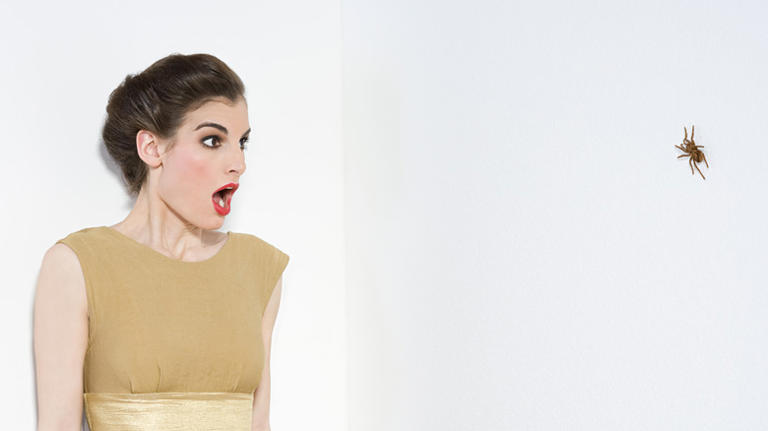

IMAGES
VIDEO
COMMENTS
Bites and venom. Brazilian wandering spiders' venom is a complex cocktail of toxins, proteins and peptides, according to the Natural History Museum in Karlsruhe, Germany. The venom affects ion ...
A bite from a Brazilian wandering spider (Phoneutria nigriventer) can cause an erection that lasts up to four hours. On Aug. 14, 2023, the account First Doctor posted what it asserted to be an ...
Phoneutria nigriventer is a species of medically significant spider in the family Ctenidae, found in the Southern Cone of South America (Brazil, Uruguay, Paraguay, and Argentina). Along with other members of the genus, they are often referred to as Brazilian wandering spiders.. Its bite can cause severe symptoms, including increased pulse, blood pressure, and respiratory rate; extraordinary ...
The Brazilian wandering spider is a highly venomous and aggressive spider. Also known as the 'banana' spider (because these spiders are frequently found in shipments of bananas), the Brazilian wandering spider 'wanders' the jungle floor as opposed to living in a lair or building a web. ... Brazilian Wandering Spider Bite On Humans. If ...
The Brazilian Wandering Spider is a hunter of incredible power and once it targets its victim, the outcome is certain. Subscribe: http://bit.ly/NatGeoSubs...
Envenomation and Its Effects. When a Brazilian wandering spider bites, it injects venom that can lead to various symptoms such as: Pain that radiates from the bite. Muscle cramps. Increased sweating. Although bites are rarely fatal, serious complications can arise when left untreated, potentially leading to death.
Learn about the Brazilian Wandering Spider, the most venomous animal in the world according to Guinness Book of World Records. Find out its characteristics, diet, reproduction and how to treat its painful and potentially life-threatening bite.
Phoneutria is a genus of spiders in the family Ctenidae.They are mainly found in northern South America, with one species in Central America. Members of the genus are commonly referred to as Brazilian wandering spiders. Other English names include armed spiders (armadeiras in Brazilian Portuguese) and banana spiders (a name shared with several others).
Clean the bite site with soap and water. Put a wet, cold cloth, or an ice pack on the bite site. Seek urgent medical attention, and bring the spider with you to help with identification, when possible. First aid administration: The First Aid for Brazilian Wandering Spider Bites includes cleaning the bite area and seeking medical attention.
Spider bites is a common problem among people, however few of them are harmful but delay in treatment can cause death. ... commonly known as Brazilian wandering spider or armed spider. Image source:wikipedia.org ... Peng Y. Bioaccumulation of mer-cury and its effects on survival, development and web-weaving in the Funnel-Web spider agelena ...
Ctenus ferus (Perty, 1833) Ctenus sus Strand, 1909. Phoneutria fera is a species of spider with medically significant venom in the family Ctenidae found in South America ( Colombia, Ecuador, Peru, Brazil, Suriname, and Guyana ). [1] It is commonly known as the Brazilian wandering spider and the banana spider, [2] although these names are ...
Brazilian Wandering Spider bites can have a range of effects on the human body, including intense pain, muscle cramps, fever, nausea, and in severe cases, paralysis. The severity of the symptoms depends on factors such as the amount of venom injected and the individual's sensitivity to the venom. There are several types of spider bites.
In the event of a Brazilian Wandering Spider bite, immediate action is necessary. First and foremost, it is essential to stay calm and seek medical help without delay. ... Even after the initial treatment of a Brazilian Wandering Spider bite, long-term effects may persist. Some individuals may experience residual pain, muscle weakness, or ...
This species is reputed to have the most toxic venom of any spider, having a bite which causes horrendous side-effects like priapism and convulsions. What you may not know, however, is that the Brazilian Wandering Spider name is actually used for a few species. ... actual deaths from Brazilian Wandering Spider bites are rare. This is largely ...
Yes, a bite from a Brazilian Wandering Spider, or Phoneutria fera, can be quite painful. It can lead to immediate intense pain and discomfort. Furthermore, if not treated promptly, the spider's venom can cause more severe symptoms, including sweating, high blood pressure, and even heart problems.
Like the Brazilian wandering spider, the venom of A. robustus can be neutralized by anti-venoms but some cases still lead to deaths when these arachnids bite a human, who did not receive any ...
Anything foolhardy enough to call this bluff gets a wealth of envenomation effects. 2 3. 5. They give some men erections. There are ways to accomplish this with fewer side effects, but a bit from a Brazilian wandering spider does come with a certain Viagral quality. This isn't as fun as it might sound.
What Are The Effects Of A Brazilian Wandering Spider Bite? Brazilian wandering spiders often make the news because of the unusual symptoms caused to humans after being bitten by one. A 2023 study in Frontiers In Molecular Biosciences suggested there were around 4,000 cases of people being bitten by Phoneutria nigriventer in Brazil each year. ...
A single bite from the Brazilian wandering spider has been shown to have side effects including a four-hour-long erection," read part of the article. ... the bite of a Brazilian wandering spider ...
In 2007, researchers found that the bites of the Brazilian wandering spider can cause long and painful erections in human males, along with other symptoms. The effect happens because the spider's ...
September 12, 2012. The Brazilian wandering spider Techuser. A bite from the banana spider (also known as the Brazilian wandering spider) of Central and South American rain forests causes ...
Brazilian Wandering Spider The Brazilian wandering spider, Phoneutria spp., found in South and Central America, is known for its highly venomous bite and aggressive hunting behavior.